Yeah, so I dicked up the first article. This one will be a little bit better, but still needs improvement to be perfect.
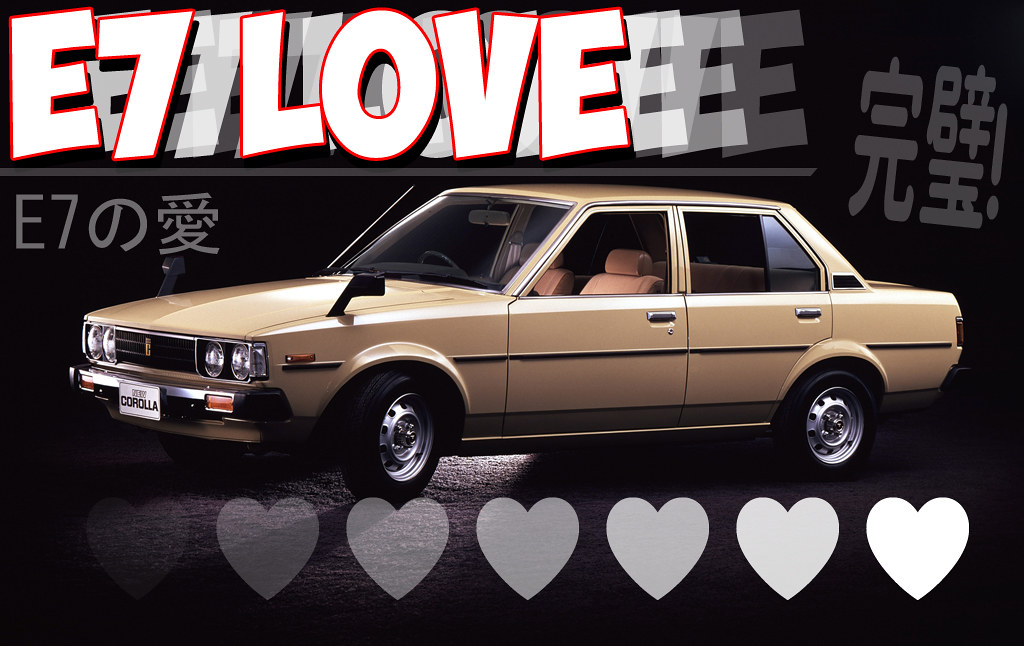 On a whim while building my scooter I asked Joel; "How many body styles of the E7 are there actually?" "I unno," he muttered back. Having reviewed my original E7 article long ago, I realized it was crappy, like all the other things I post. I spent a few hours collecting photos, to help build a better article than before.
For those of you in the know, the "E" in the chassis code is often associated with the Corolla name. What people often forget is that the Sprinter line of cars are also E Chassis codes. Corolla and Sprinter are both equally E chassis lines, the model of each follows after. For example; Toyota Corolla Levin, and Toyota Sprinter Trueno. Toyota is the manufacturer, Corolla is the line, and Levin is the model. This article includes both Corollas and Sprinters which have E7 Chassis codes.
What's special about the E7? It's a world car, meaning it was sold on every continent! I can go anywhere in the world and if I look hard enough I'll be able to find an E7 somewhere! I love world cars.
Body Styles:
Let's just jump to the meat of this article. How many are there? By my unofficial count there are approximately 20. You can call me out if you want, or send me some new information.
Within these body styles are 2 basic groups: Sedan and Sports. All E7's share a similar floor pans, for the most part. Wagons were leaf sprung, their rear half is a different section of floor pan than all other body styles. Note: that Left Hand drive cars with "T" series engines had a completely different firewall than all other E7 chassis!!! This affected the dash bar and pedal assemblies on these cars as well.
The noses between sedan models can be swapped between sedans, the same with the sports models as well, however, a sports nose and sedan nose cannot be swapped.
Sedans:
[caption id="" align="aligncenter" width="1024"]
On a whim while building my scooter I asked Joel; "How many body styles of the E7 are there actually?" "I unno," he muttered back. Having reviewed my original E7 article long ago, I realized it was crappy, like all the other things I post. I spent a few hours collecting photos, to help build a better article than before.
For those of you in the know, the "E" in the chassis code is often associated with the Corolla name. What people often forget is that the Sprinter line of cars are also E Chassis codes. Corolla and Sprinter are both equally E chassis lines, the model of each follows after. For example; Toyota Corolla Levin, and Toyota Sprinter Trueno. Toyota is the manufacturer, Corolla is the line, and Levin is the model. This article includes both Corollas and Sprinters which have E7 Chassis codes.
What's special about the E7? It's a world car, meaning it was sold on every continent! I can go anywhere in the world and if I look hard enough I'll be able to find an E7 somewhere! I love world cars.
Body Styles:
Let's just jump to the meat of this article. How many are there? By my unofficial count there are approximately 20. You can call me out if you want, or send me some new information.
Within these body styles are 2 basic groups: Sedan and Sports. All E7's share a similar floor pans, for the most part. Wagons were leaf sprung, their rear half is a different section of floor pan than all other body styles. Note: that Left Hand drive cars with "T" series engines had a completely different firewall than all other E7 chassis!!! This affected the dash bar and pedal assemblies on these cars as well.
The noses between sedan models can be swapped between sedans, the same with the sports models as well, however, a sports nose and sedan nose cannot be swapped.
Sedans:
[caption id="" align="aligncenter" width="1024"]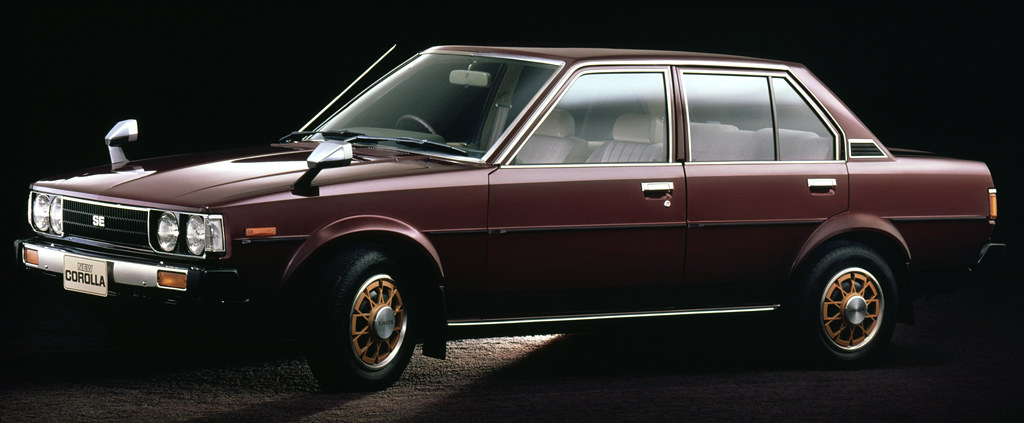 4 Door Corolla Sedan. Note the rear door shape and C-pillar shape, This differs between the Sprinter 4 door sedan pictured below. These Corolla rear sedan doors differ from the rear wagon doors. Pictured is the tried and true classic, and what model people know as an "E7" or often referred to as a complete chassis code of "KE70". This is the most common bodystyle found internationally. The nose and taillights may differ depending on year and continent. There were 3 basic versions, and Early, Mid, and Late version of the Corolla sedan. The Early version is pictured above with the "Quads" nose. We'll cover all in this article.[/caption]
[caption id="" align="aligncenter" width="1024"]
4 Door Corolla Sedan. Note the rear door shape and C-pillar shape, This differs between the Sprinter 4 door sedan pictured below. These Corolla rear sedan doors differ from the rear wagon doors. Pictured is the tried and true classic, and what model people know as an "E7" or often referred to as a complete chassis code of "KE70". This is the most common bodystyle found internationally. The nose and taillights may differ depending on year and continent. There were 3 basic versions, and Early, Mid, and Late version of the Corolla sedan. The Early version is pictured above with the "Quads" nose. We'll cover all in this article.[/caption]
[caption id="" align="aligncenter" width="1024"]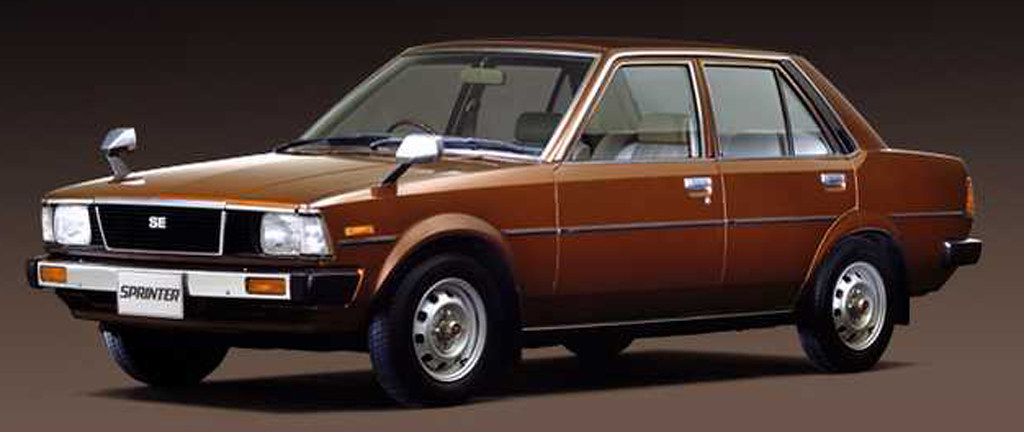 4 Door Sedan Sprinter. These doors are compatible with the wagon 4 door rear doors, as far as I know. These are extremely rare. Pictured is an early version of the Sprinter, most likely a 1979.[/caption]
[caption id="" align="aligncenter" width="1024"]
4 Door Sedan Sprinter. These doors are compatible with the wagon 4 door rear doors, as far as I know. These are extremely rare. Pictured is an early version of the Sprinter, most likely a 1979.[/caption]
[caption id="" align="aligncenter" width="1024"]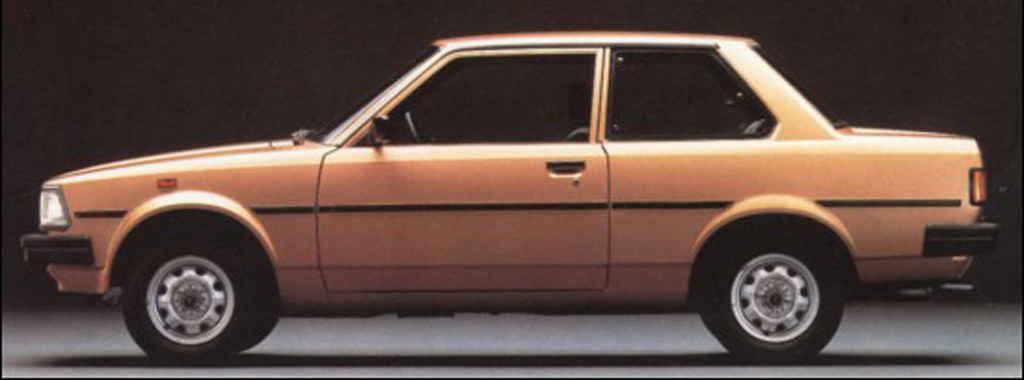 2 Door Sedan. This is NOT the coupe. It's easy to call it a coupe, due to only having 2 doors, but there is a Sports model by that name already. This is the 2 door sedan. Pictured above is a late model European nose and taillights.[/caption]
Sedans subcatagory: Wagons/Vans
This is where things get really tricky. There is TONS of versions of the wagon/van. I tried my absolute best to get every version of the wagon/van. Please ignore the noses, as they are interchangeable. The doors, roof height and the windows equipped are the variations that are important. Some of these were called "Vans" because in Japan a 'Van' denotes purpose for work, and 'Wagon' denotes purpose for home/pleasure.
--Low Roof
[caption id="" align="aligncenter" width="1024"]
2 Door Sedan. This is NOT the coupe. It's easy to call it a coupe, due to only having 2 doors, but there is a Sports model by that name already. This is the 2 door sedan. Pictured above is a late model European nose and taillights.[/caption]
Sedans subcatagory: Wagons/Vans
This is where things get really tricky. There is TONS of versions of the wagon/van. I tried my absolute best to get every version of the wagon/van. Please ignore the noses, as they are interchangeable. The doors, roof height and the windows equipped are the variations that are important. Some of these were called "Vans" because in Japan a 'Van' denotes purpose for work, and 'Wagon' denotes purpose for home/pleasure.
--Low Roof
[caption id="" align="aligncenter" width="1024"]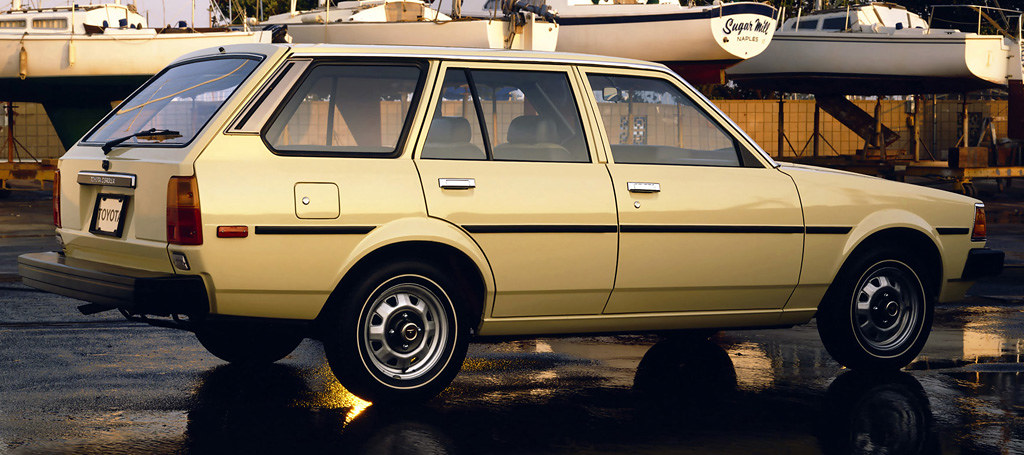 Low Roof 4 Door Wagon. This is the most common of the E7 chassis's. It is also the second most common of all E7's made, next two the Corolla 4 door sedan.[/caption]
[caption id="" align="aligncenter" width="1024"]
Low Roof 4 Door Wagon. This is the most common of the E7 chassis's. It is also the second most common of all E7's made, next two the Corolla 4 door sedan.[/caption]
[caption id="" align="aligncenter" width="1024"]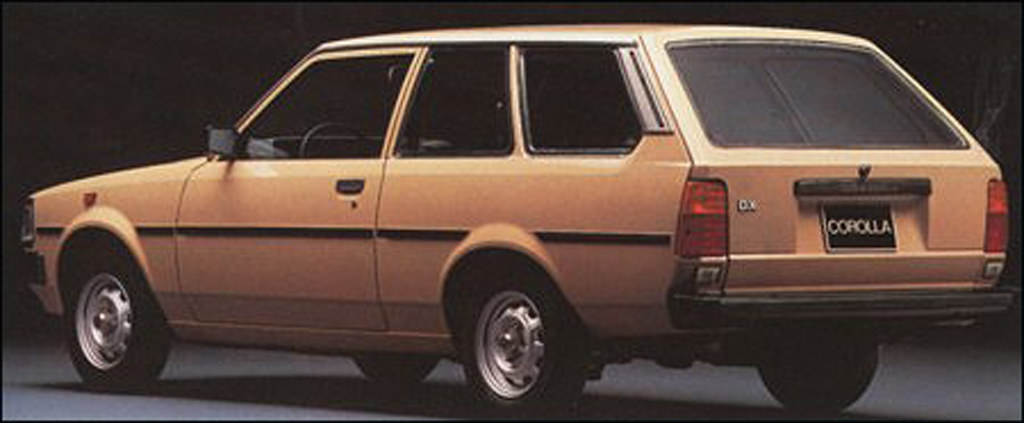 Low Roof 2 Door Wagon, Factory Glass. The rear windows on this were not dealer installed, but factory installed. The front doors of this MAY (unconfirmed) swap between the 2 door sedan.[/caption]
[caption id="" align="aligncenter" width="1024"]
Low Roof 2 Door Wagon, Factory Glass. The rear windows on this were not dealer installed, but factory installed. The front doors of this MAY (unconfirmed) swap between the 2 door sedan.[/caption]
[caption id="" align="aligncenter" width="1024"]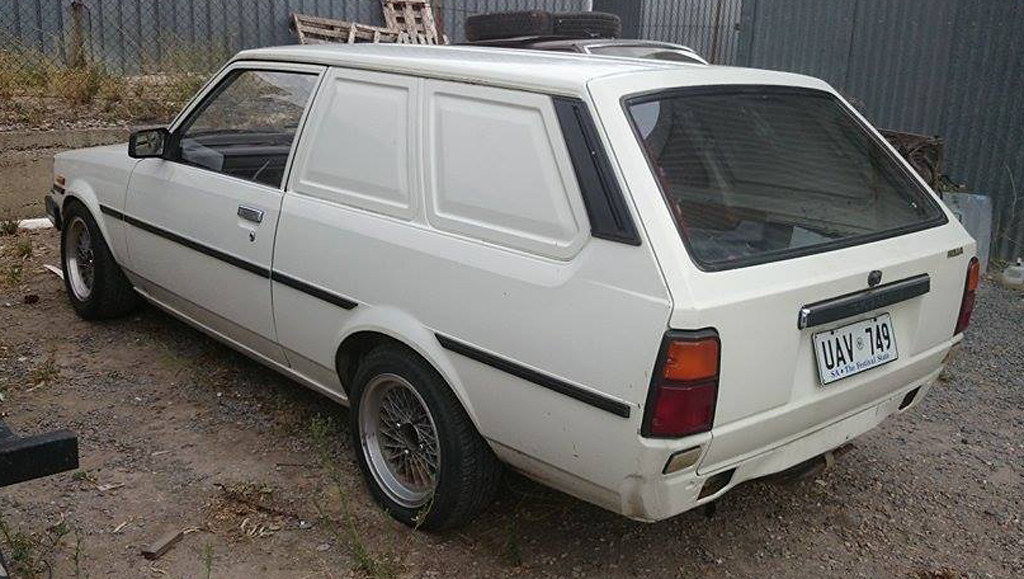 Low Roof 2 Door Wagon. This is the Panel van. It has stamped steel sheet where the factory windows could've been installed.[/caption]
[caption id="" align="aligncenter" width="1024"]
Low Roof 2 Door Wagon. This is the Panel van. It has stamped steel sheet where the factory windows could've been installed.[/caption]
[caption id="" align="aligncenter" width="1024"]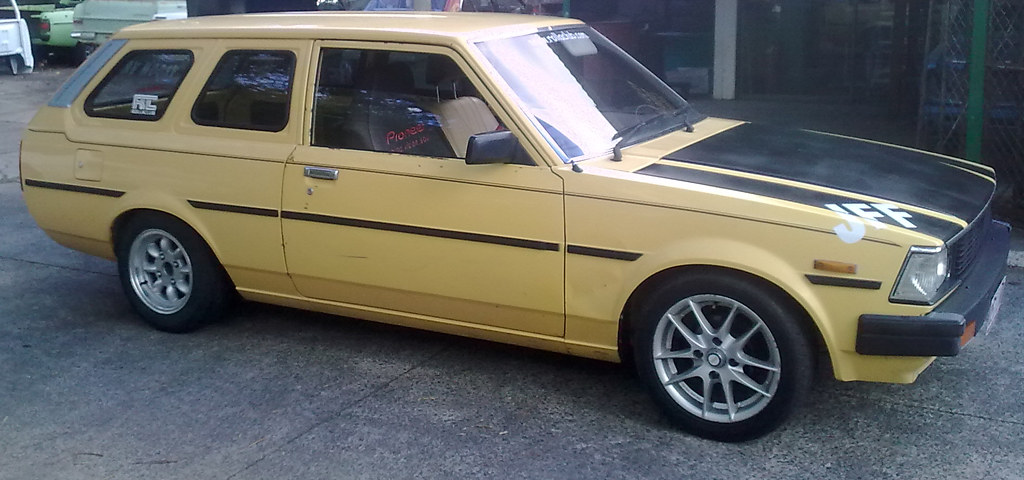 Low Roof 2 Door Wagon, Dual Dealer Windows. The wagons are complex. Windows in the rear were optional for customers needs. Often these cars were used as work vans, and customers could decide which windows they wanted installed. You'll notice the glass is smaller on the panel windows than on the factory installed windows.[/caption]
[caption id="" align="aligncenter" width="1024"]
Low Roof 2 Door Wagon, Dual Dealer Windows. The wagons are complex. Windows in the rear were optional for customers needs. Often these cars were used as work vans, and customers could decide which windows they wanted installed. You'll notice the glass is smaller on the panel windows than on the factory installed windows.[/caption]
[caption id="" align="aligncenter" width="1024"]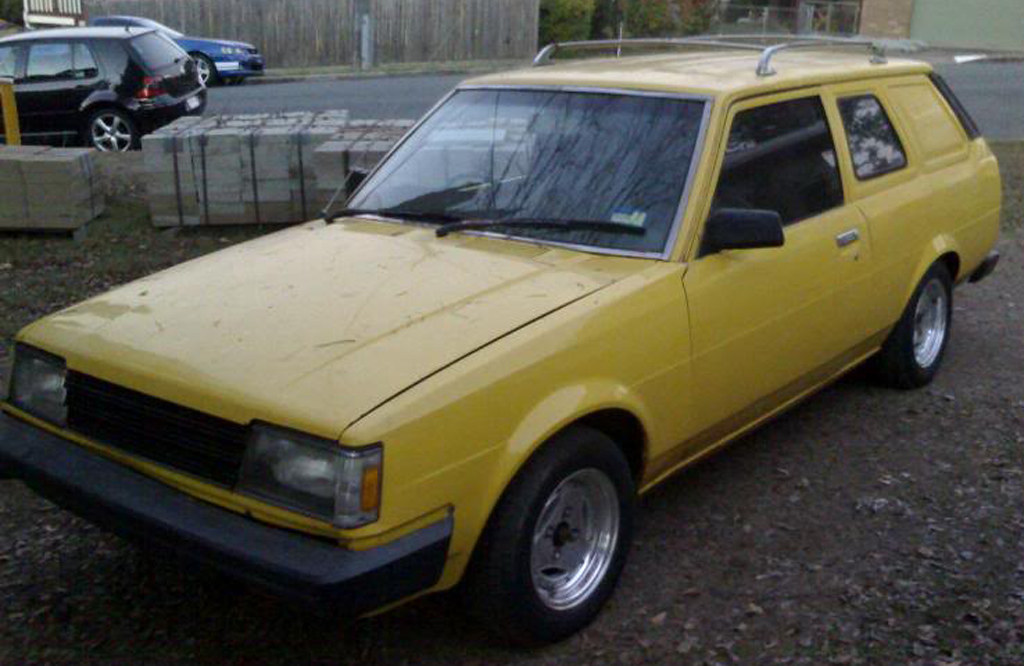 Low Roof 2 Door Wagon, Front Dealer Window. This customer opted for only the front of the dealer installed panel windows.[/caption]
[caption id="" align="aligncenter" width="1024"]
Low Roof 2 Door Wagon, Front Dealer Window. This customer opted for only the front of the dealer installed panel windows.[/caption]
[caption id="" align="aligncenter" width="1024"]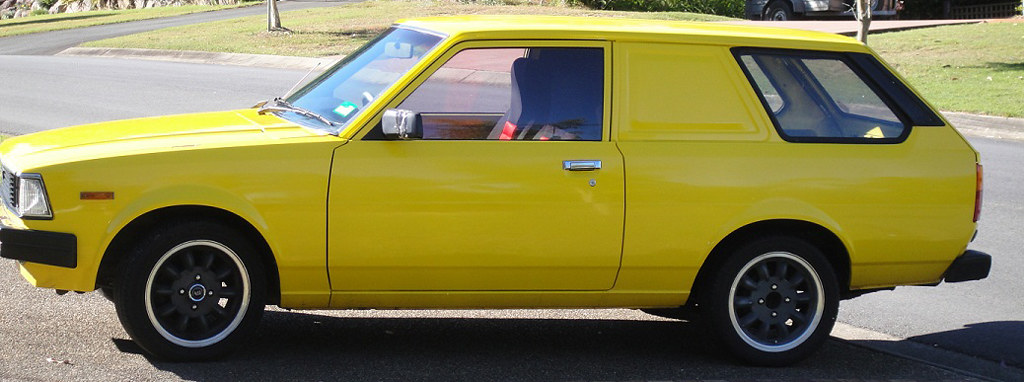 Low Roof 2 Door Wagon, Rear Window. This is a bit of a cheat as the rear are factory windows. There were many dealer installed styles like this.[/caption]
--High Roof
These featured a higher roof than standard models for more head and cargo space.
[caption id="" align="aligncenter" width="1024"]
Low Roof 2 Door Wagon, Rear Window. This is a bit of a cheat as the rear are factory windows. There were many dealer installed styles like this.[/caption]
--High Roof
These featured a higher roof than standard models for more head and cargo space.
[caption id="" align="aligncenter" width="1024"]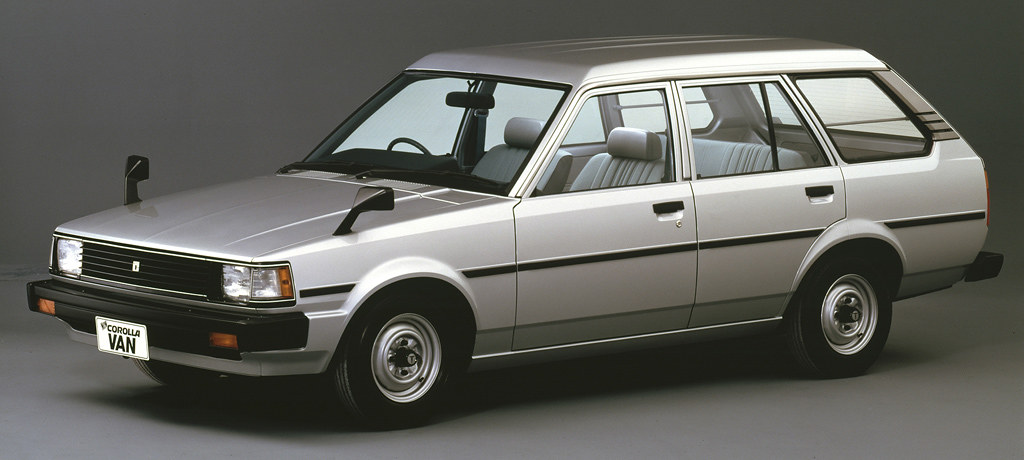 High Roof 4 Door Wagon. This also features a rare, Japan only "Van" nose, which looks similar to the Carina van's of the time.[/caption]
[caption id="" align="aligncenter" width="1024"]
High Roof 4 Door Wagon. This also features a rare, Japan only "Van" nose, which looks similar to the Carina van's of the time.[/caption]
[caption id="" align="aligncenter" width="1024"] High Roof 2 Door Wagon, Factory Windows. This is a famous drift car owned by Katsuhiro Ueo. It too has the Japanese only "Van" nose.[/caption]
[caption id="" align="aligncenter" width="1024"]
High Roof 2 Door Wagon, Factory Windows. This is a famous drift car owned by Katsuhiro Ueo. It too has the Japanese only "Van" nose.[/caption]
[caption id="" align="aligncenter" width="1024"]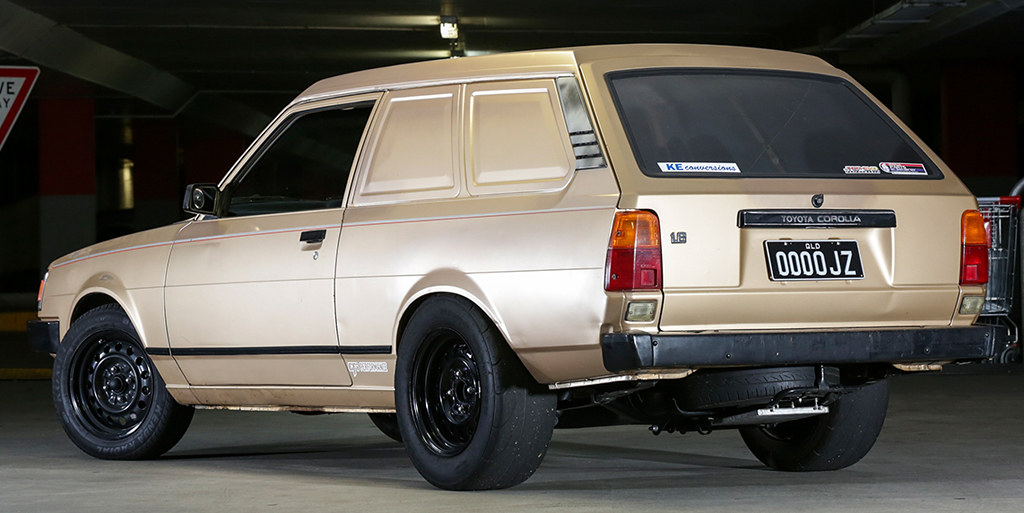 High Roof 2 Door Wagon. This is the Panel van version. This is my favorite of all the E7 chassis types. Most commonly found in Australia, but were also sold in Europe.[/caption]
[caption id="" align="aligncenter" width="1024"]
High Roof 2 Door Wagon. This is the Panel van version. This is my favorite of all the E7 chassis types. Most commonly found in Australia, but were also sold in Europe.[/caption]
[caption id="" align="aligncenter" width="1024"]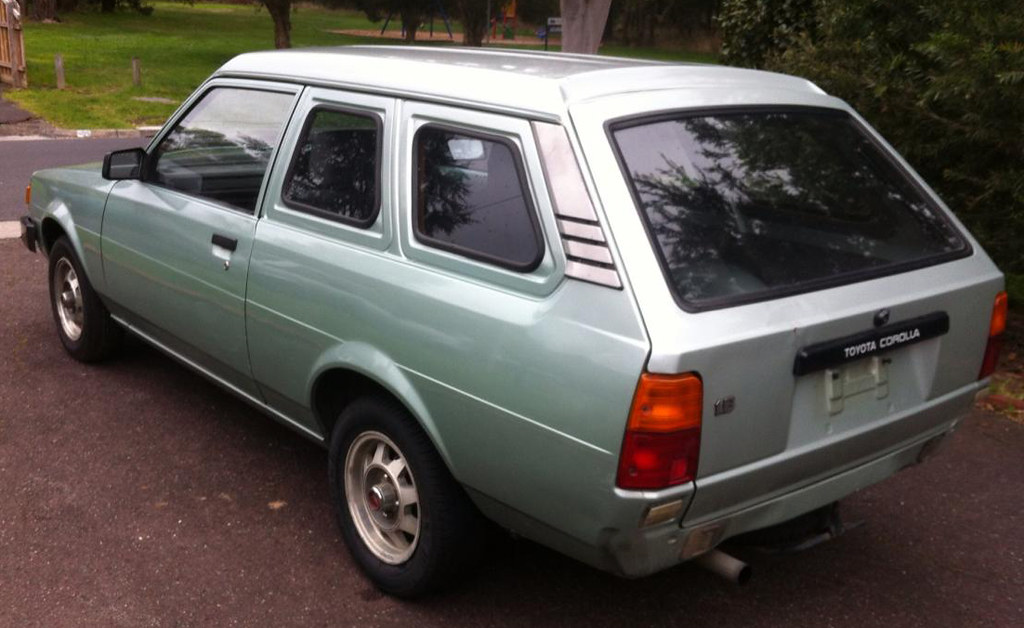 High Roof 2 Door Wagon, Dual Dealer Windows.[/caption]
[caption id="" align="aligncenter" width="1024"]
High Roof 2 Door Wagon, Dual Dealer Windows.[/caption]
[caption id="" align="aligncenter" width="1024"]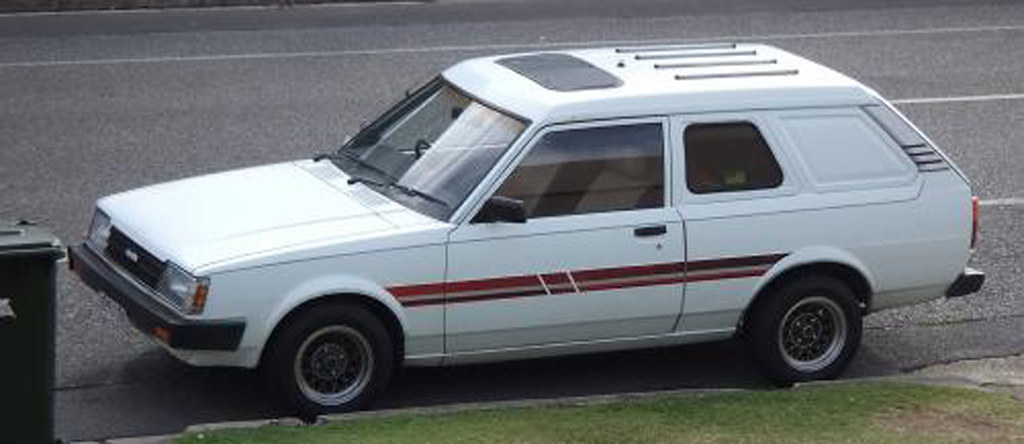 High Roof 2 Door Wagon, Front Dealer Window. This is a late model Australian, which was sold as a Corolla, even though they used the late Japanese Sprinter nose. It is common for the Australian models to mix and match Sprinter and Corolla parts from the Factory.[/caption]
[caption id="" align="aligncenter" width="1024"]
High Roof 2 Door Wagon, Front Dealer Window. This is a late model Australian, which was sold as a Corolla, even though they used the late Japanese Sprinter nose. It is common for the Australian models to mix and match Sprinter and Corolla parts from the Factory.[/caption]
[caption id="" align="aligncenter" width="1024"]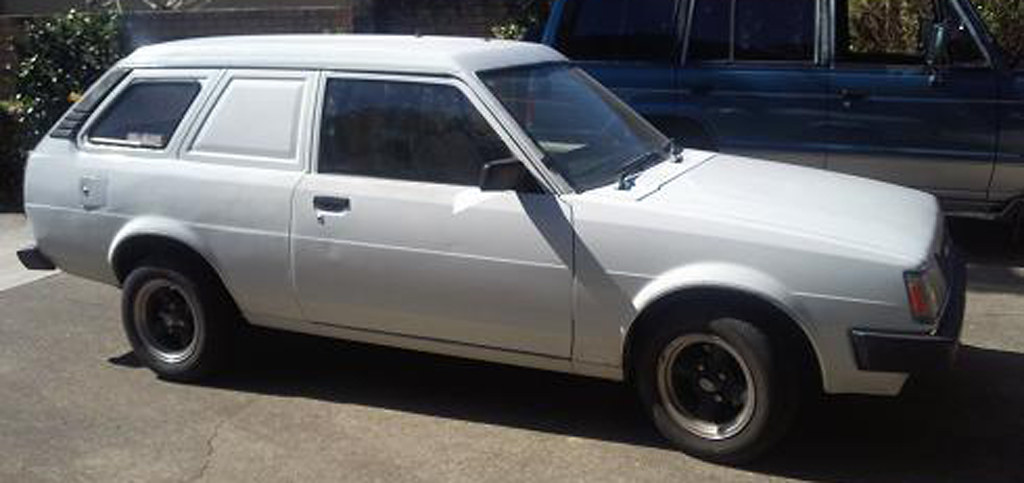 High Roof 2 Door Wagon, Rear Dealer Window.[/caption]
Sports
These body styles, although the same underpan and engine bay as the sedans, have a completely different body line than the Sedan style cars above. Only Noses and taillights can be swapped between sport body styles. The sedan exterior parts are not compatible.
[caption id="" align="aligncenter" width="1024"]
High Roof 2 Door Wagon, Rear Dealer Window.[/caption]
Sports
These body styles, although the same underpan and engine bay as the sedans, have a completely different body line than the Sedan style cars above. Only Noses and taillights can be swapped between sport body styles. The sedan exterior parts are not compatible.
[caption id="" align="aligncenter" width="1024"]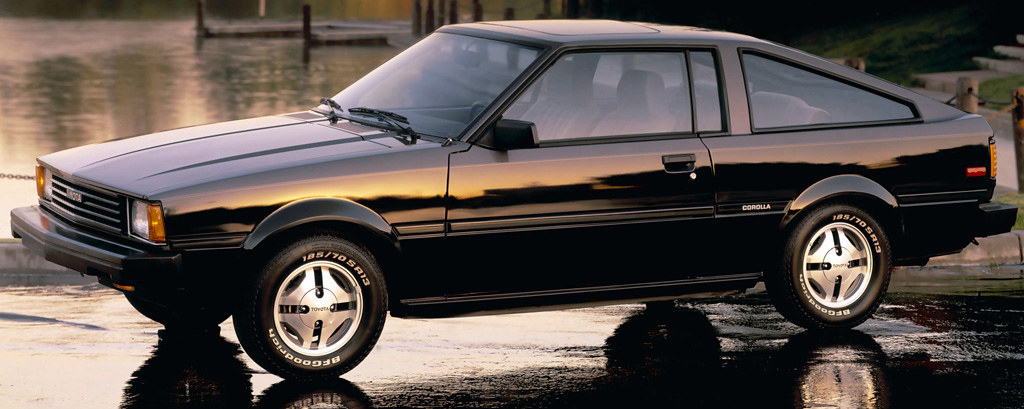 Coupe. This car is not called a hatchback, or fast back, it is the coupe. Which is often what people mistakenly call the 2 door sedan.[/caption]
[caption id="" align="aligncenter" width="1024"]
Coupe. This car is not called a hatchback, or fast back, it is the coupe. Which is often what people mistakenly call the 2 door sedan.[/caption]
[caption id="" align="aligncenter" width="1024"]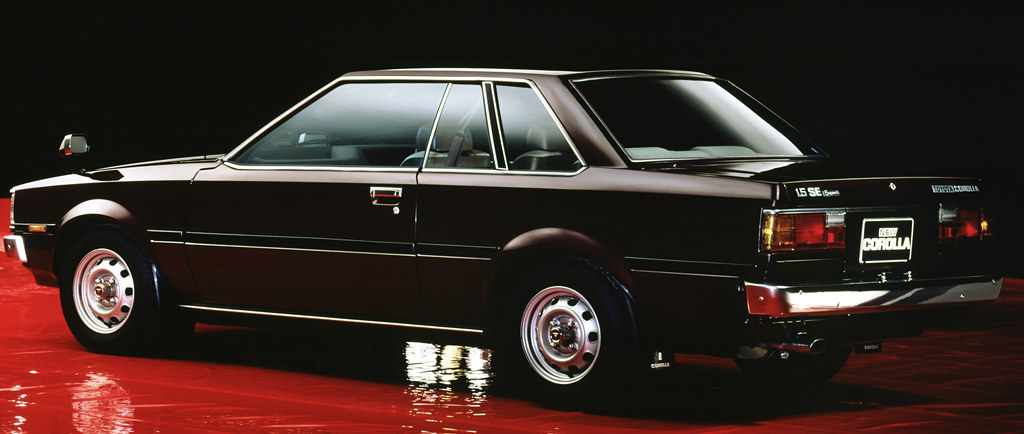 Hardtop. It's a strange name, but it's a throw back name to cars of the 1960's. "Hardtop" meant a car with a hard roof, but no "B" pillars. This was an American term that the Japanese continued to use until "Hardtop" designs were banned for better roll over protection. Both this car pictured above, and the one below have the same missing B-pillar. The door windows roll down, but also the small triangular windows behind the front door also roll down for rear passengers.[/caption]
[caption id="" align="aligncenter" width="1024"]
Hardtop. It's a strange name, but it's a throw back name to cars of the 1960's. "Hardtop" meant a car with a hard roof, but no "B" pillars. This was an American term that the Japanese continued to use until "Hardtop" designs were banned for better roll over protection. Both this car pictured above, and the one below have the same missing B-pillar. The door windows roll down, but also the small triangular windows behind the front door also roll down for rear passengers.[/caption]
[caption id="" align="aligncenter" width="1024"]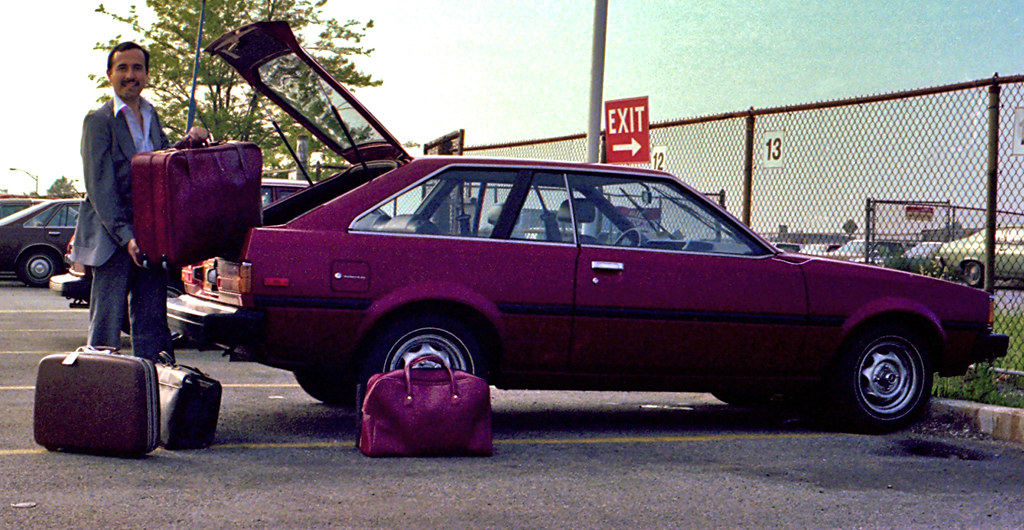 Liftback. This shares the missing B-pillar with the hardtop. It functions like owning a 2-door Wagon, but is called a Liftback and has Sport type body panels. Weirdly enough this was sold as a completely separate model in Australia labeled "T18". This was to denote it's 3TC engine, where all other E7 corollas in Australia had 4KC or 4AC engines with steering racks, the T18 was the only model with the 3TC and steering box.[/caption]
[caption id="" align="aligncenter" width="1024"]
Liftback. This shares the missing B-pillar with the hardtop. It functions like owning a 2-door Wagon, but is called a Liftback and has Sport type body panels. Weirdly enough this was sold as a completely separate model in Australia labeled "T18". This was to denote it's 3TC engine, where all other E7 corollas in Australia had 4KC or 4AC engines with steering racks, the T18 was the only model with the 3TC and steering box.[/caption]
[caption id="" align="aligncenter" width="1024"]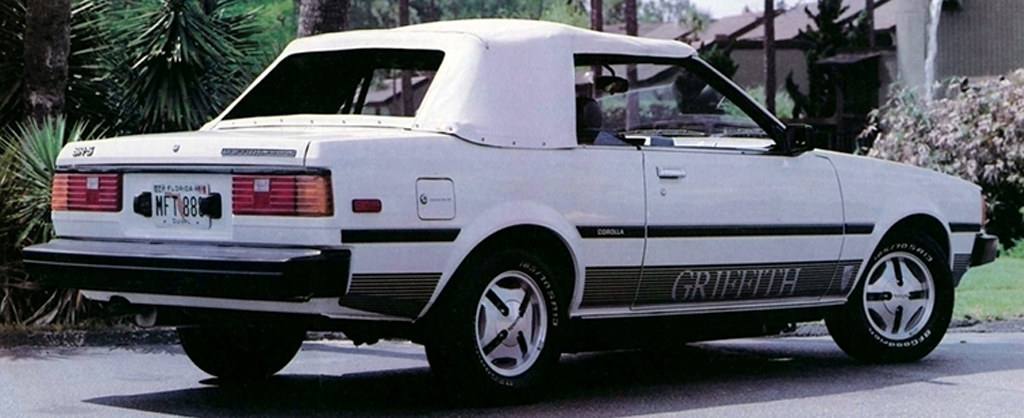 Convertible. A rare, American only model. This was converted by coach builder Griffith on Toyotas behalf and sold through the Toyota dealership.[/caption]
Bonus Car!!!
[caption id="" align="aligncenter" width="1024"]
Convertible. A rare, American only model. This was converted by coach builder Griffith on Toyotas behalf and sold through the Toyota dealership.[/caption]
Bonus Car!!!
[caption id="" align="aligncenter" width="1024"]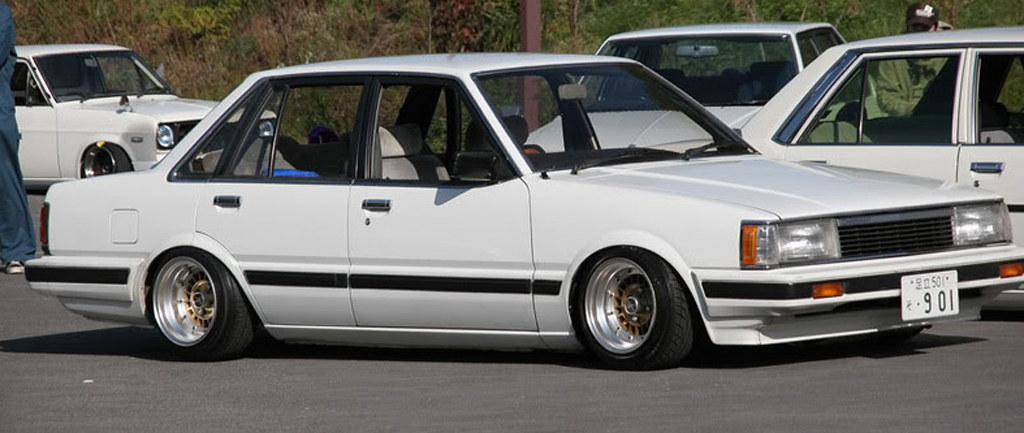 Daihatsu Charmant. Yes, this is an E7! Toyota owns Daihatsu and the two are often sharing models. This is a completely rebodied E7 but shares the entire floor pan with the regular Sedan based models.[/caption]
Noses:
Here we cover the basic versions of front ends available on the differing E7 models. Use this as a rough guide for identification of year and continent of origin.
Sedans:
[caption id="" align="aligncenter" width="1024"]
Daihatsu Charmant. Yes, this is an E7! Toyota owns Daihatsu and the two are often sharing models. This is a completely rebodied E7 but shares the entire floor pan with the regular Sedan based models.[/caption]
Noses:
Here we cover the basic versions of front ends available on the differing E7 models. Use this as a rough guide for identification of year and continent of origin.
Sedans:
[caption id="" align="aligncenter" width="1024"]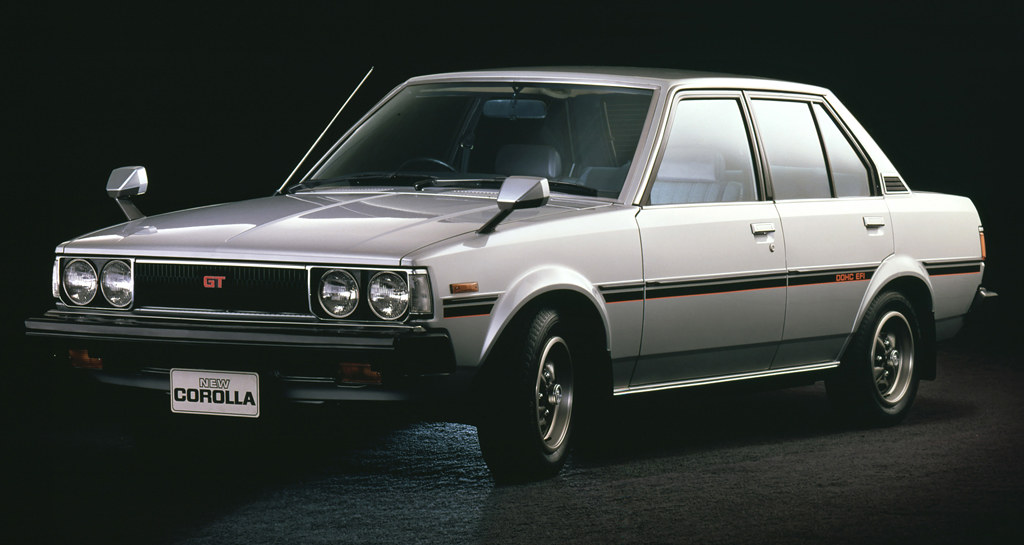 Sedan Corolla Early. This is the famous and most loved "Quads" nose. It only fits on sedan based models. Quads were a 1979-1980 only option found in Japan and North America. Pictured above is a 1980, as 79's had silver, not black, headlight buckets.[/caption]
[caption id="" align="aligncenter" width="1024"]
Sedan Corolla Early. This is the famous and most loved "Quads" nose. It only fits on sedan based models. Quads were a 1979-1980 only option found in Japan and North America. Pictured above is a 1980, as 79's had silver, not black, headlight buckets.[/caption]
[caption id="" align="aligncenter" width="1024"]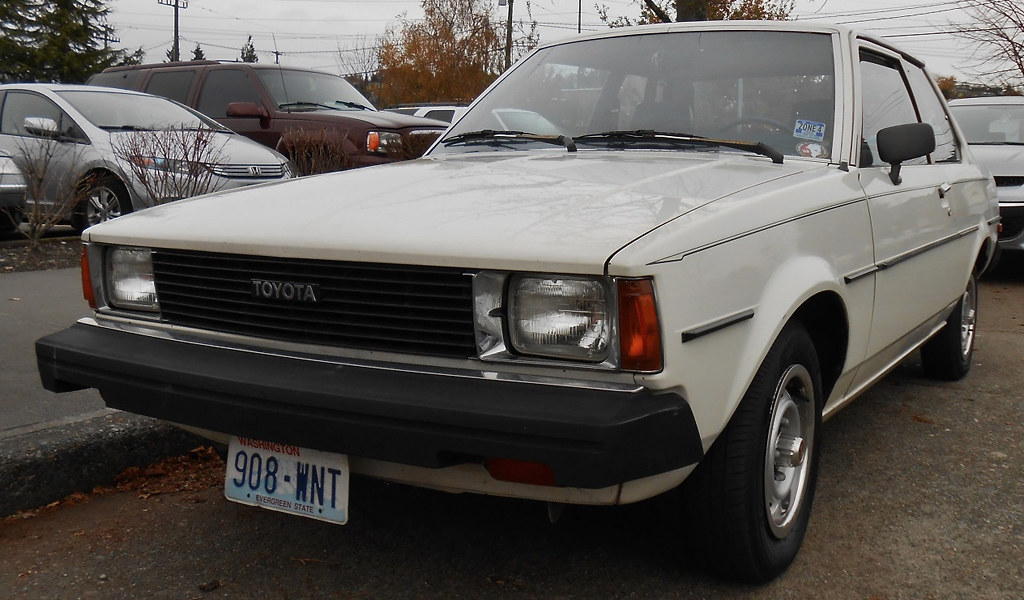 Sedan Corolla Mid. This was a 1980-81 Nose depending on your market. This is the most commonly found nose internationally. Often referred to as "flat" front. The fenders and thin corner marker lights are the same between the Flat and Quad nose, but change on the later models.[/caption]
[caption id="" align="aligncenter" width="1024"]
Sedan Corolla Mid. This was a 1980-81 Nose depending on your market. This is the most commonly found nose internationally. Often referred to as "flat" front. The fenders and thin corner marker lights are the same between the Flat and Quad nose, but change on the later models.[/caption]
[caption id="" align="aligncenter" width="1024"]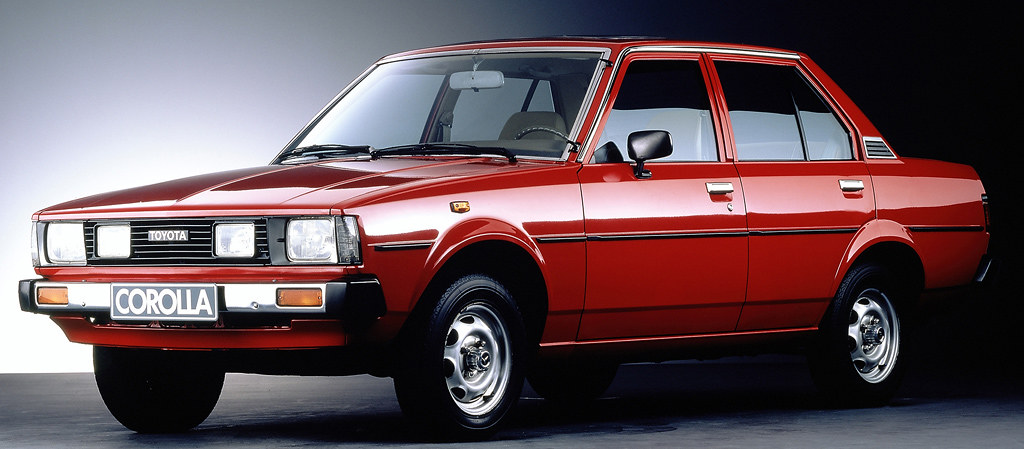 Sedan Corolla Mid. This is a rare, European only version with integrated fog lights.[/caption]
[caption id="" align="aligncenter" width="1024"]
Sedan Corolla Mid. This is a rare, European only version with integrated fog lights.[/caption]
[caption id="" align="aligncenter" width="1024"]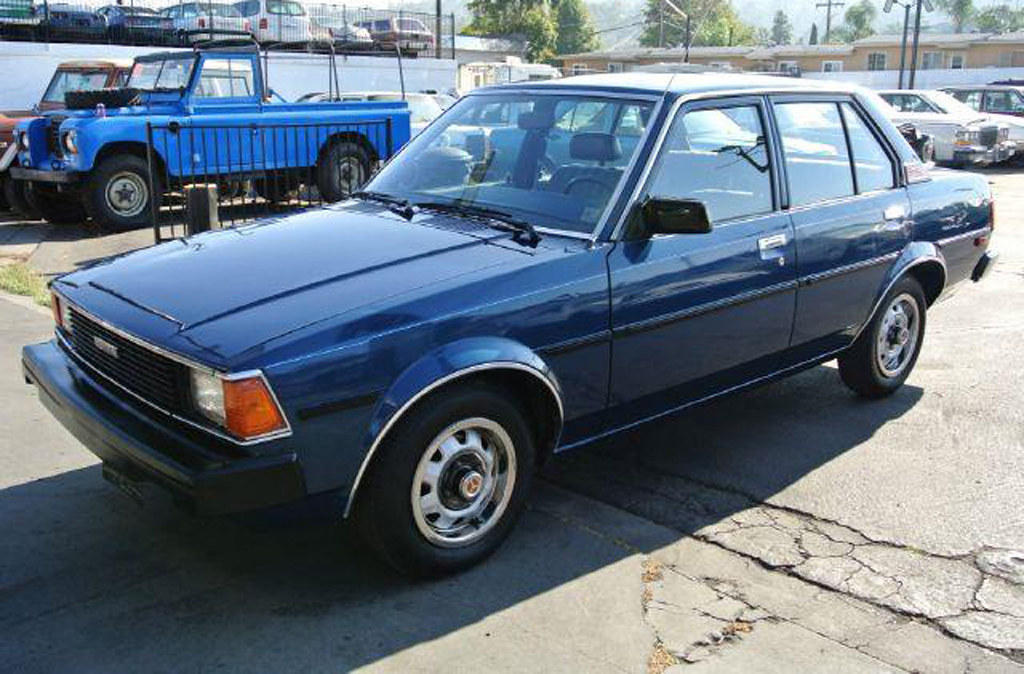 Sedan Corolla Late. The "cheese wedge" nose has unique fenders to that of the early and mid noses. Easily spotted by the large triangular corner lights. These are sometimes clear rather than amber on other markets and models. 1982-83[/caption]
[caption id="" align="aligncenter" width="1024"]
Sedan Corolla Late. The "cheese wedge" nose has unique fenders to that of the early and mid noses. Easily spotted by the large triangular corner lights. These are sometimes clear rather than amber on other markets and models. 1982-83[/caption]
[caption id="" align="aligncenter" width="1024"]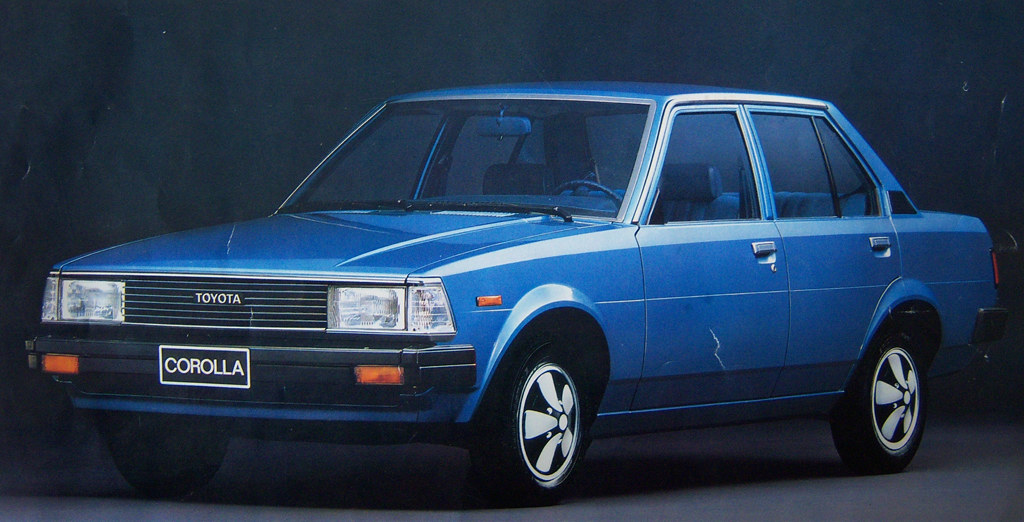 Sedan Corolla Late. This is a Japanese and European only nose with flush molded headlights and clear cheese wedge corner light fender combo. I can only assume these use an H4 replaceable bulb rather than the sealed halogens of previous models. 1982-83[/caption]
[caption id="" align="aligncenter" width="1024"]
Sedan Corolla Late. This is a Japanese and European only nose with flush molded headlights and clear cheese wedge corner light fender combo. I can only assume these use an H4 replaceable bulb rather than the sealed halogens of previous models. 1982-83[/caption]
[caption id="" align="aligncenter" width="1024"]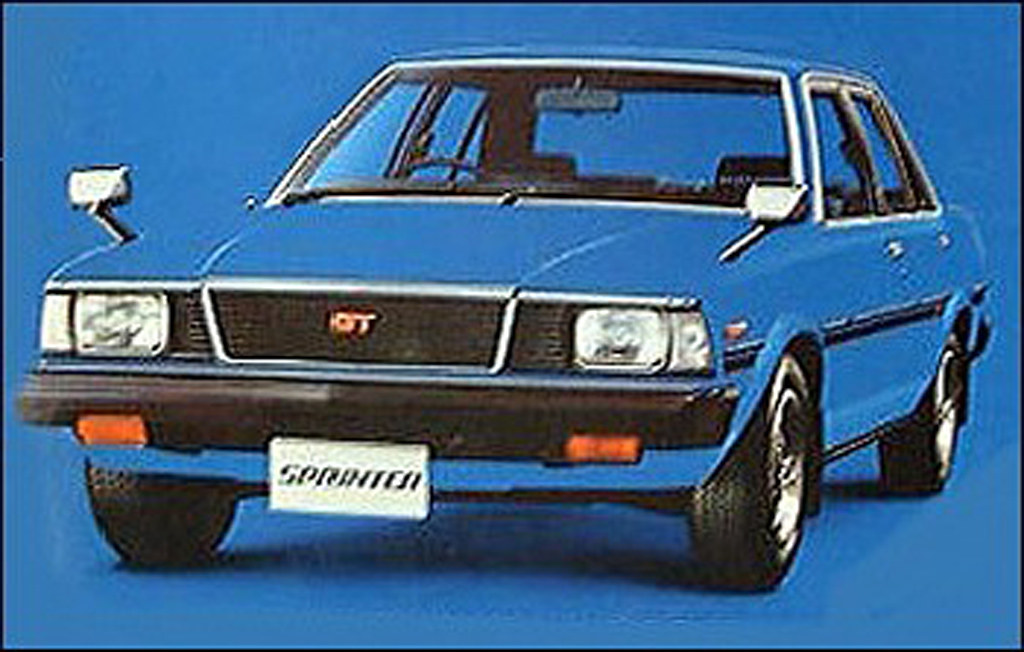 Sedan Sprinter Early. Often found on 79-80 model sprinters. Pretty rare nose as the number of Corollas sold far outweighed that of the unpopular sprinter line.[/caption]
[caption id="" align="aligncenter" width="1024"]
Sedan Sprinter Early. Often found on 79-80 model sprinters. Pretty rare nose as the number of Corollas sold far outweighed that of the unpopular sprinter line.[/caption]
[caption id="" align="aligncenter" width="1024"]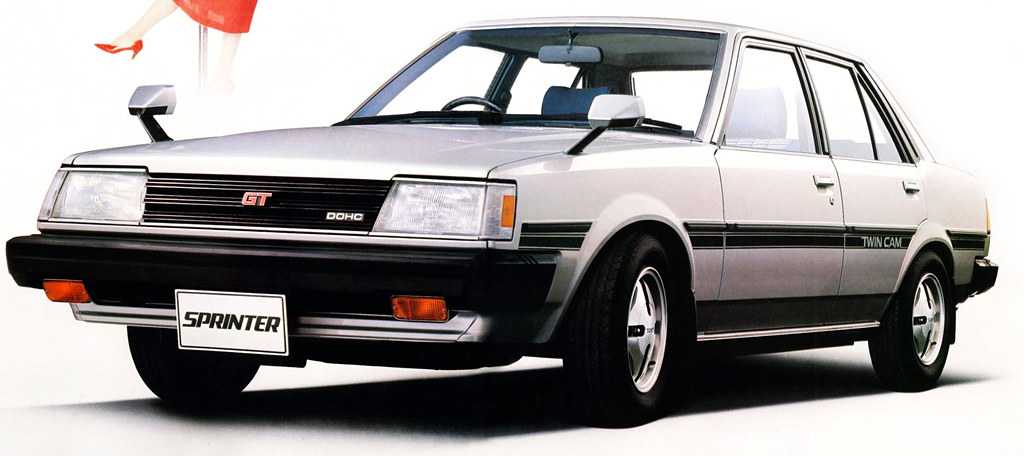 Sedan Sprinter Late. This is a tricky nose. In Japan this was a Sprinter nose, and you can confirm by the license plate and the the rear doors in this picture. However, Australia received this as their late Corolla nose. It's common for other markets outside of Japan to have Corolla and Sprinter parts mixed. Often referred to as a "slant nose". 1983 and maybe 1984 in some markets.[/caption]
Sports:
These noses are not interchangeable with Sedan noses. You will see some grill and headlight swaps between the two, but requires custom fabrication and questionable taste.
[caption id="" align="aligncenter" width="1024"]
Sedan Sprinter Late. This is a tricky nose. In Japan this was a Sprinter nose, and you can confirm by the license plate and the the rear doors in this picture. However, Australia received this as their late Corolla nose. It's common for other markets outside of Japan to have Corolla and Sprinter parts mixed. Often referred to as a "slant nose". 1983 and maybe 1984 in some markets.[/caption]
Sports:
These noses are not interchangeable with Sedan noses. You will see some grill and headlight swaps between the two, but requires custom fabrication and questionable taste.
[caption id="" align="aligncenter" width="1024"]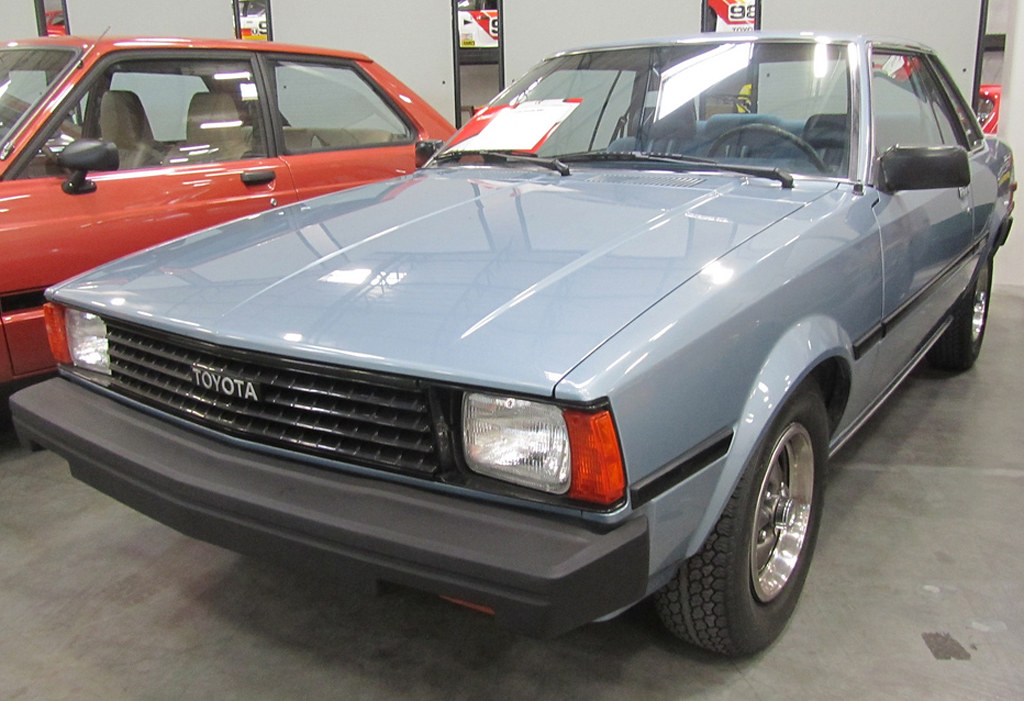 Sports Corolla Early. Pretty common nose, was used on Sports models internationally from 1979 through 1983.[/caption]
[caption id="" align="aligncenter" width="1024"]
Sports Corolla Early. Pretty common nose, was used on Sports models internationally from 1979 through 1983.[/caption]
[caption id="" align="aligncenter" width="1024"]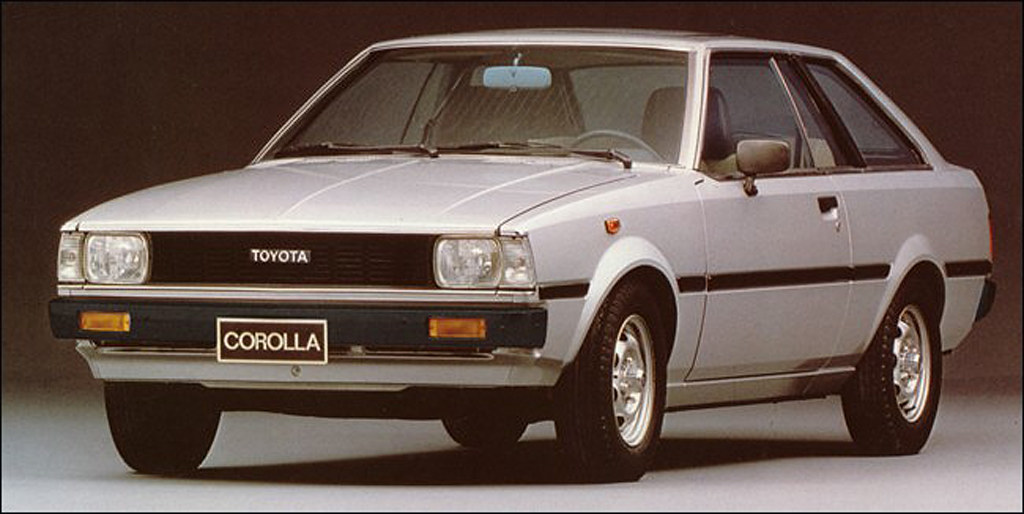 Sports Corolla Early. Same as above, but the European version with clear corners and fender marker lights.[/caption]
[caption id="" align="aligncenter" width="1024"]
Sports Corolla Early. Same as above, but the European version with clear corners and fender marker lights.[/caption]
[caption id="" align="aligncenter" width="1024"]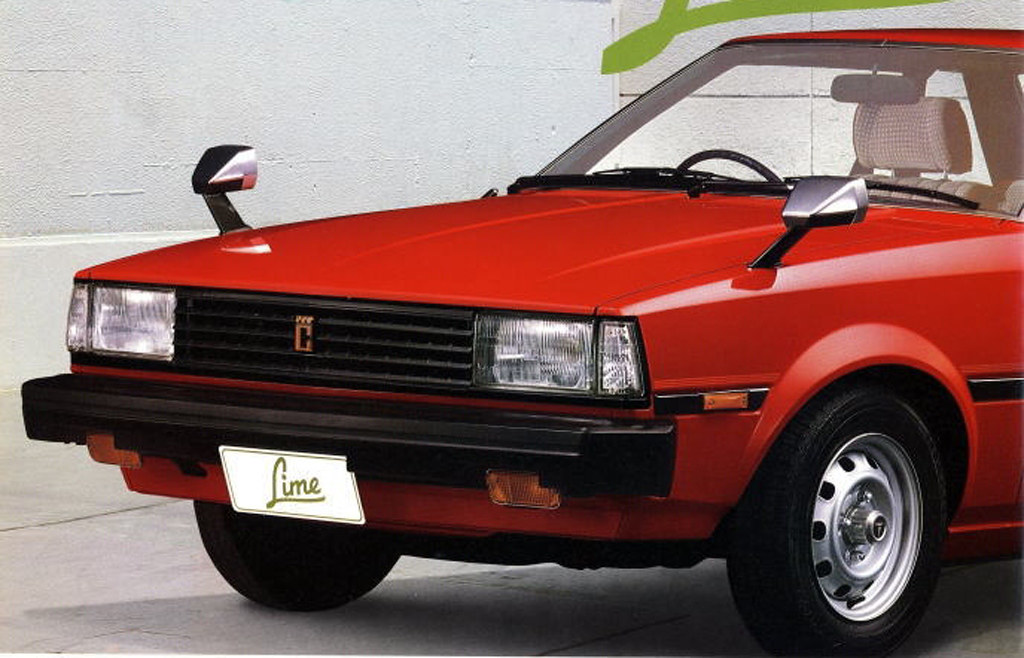 Sports Corolla Late. Flush mounted headlights. I'm pretty sure this nose was Japan only.[/caption]
[caption id="" align="aligncenter" width="1024"]
Sports Corolla Late. Flush mounted headlights. I'm pretty sure this nose was Japan only.[/caption]
[caption id="" align="aligncenter" width="1024"]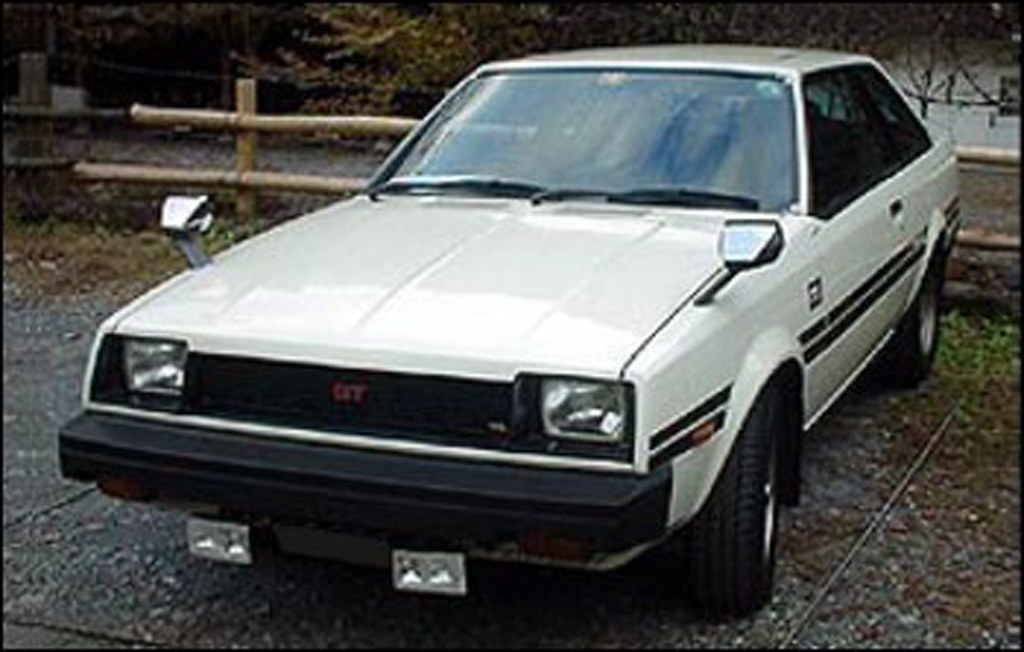 Sports Sprinter Early. Rare nose, pretty sure this is a Japanese only nose. Though I've seen E7's from the Philippians with these noses.[/caption]
[caption id="" align="aligncenter" width="1024"]
Sports Sprinter Early. Rare nose, pretty sure this is a Japanese only nose. Though I've seen E7's from the Philippians with these noses.[/caption]
[caption id="" align="aligncenter" width="1024"]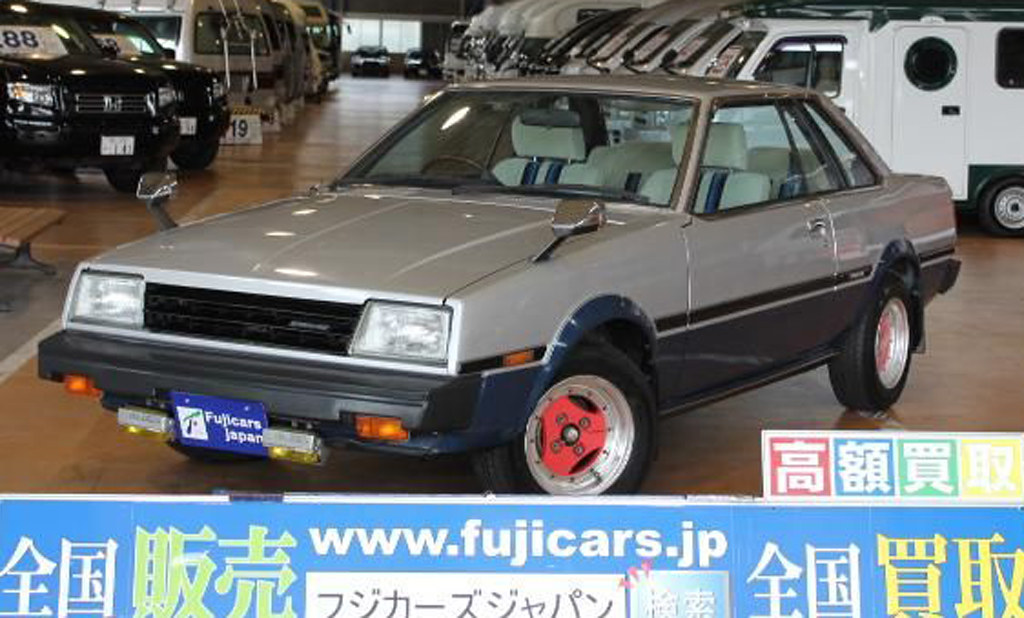 Sports Sprinter Late. Molded headlights, Japan Only.[/caption]
Tails
Mostly just variations in taillights. My information on these are a bit blurry as the back is the least common place people take photos.
Sedans
[caption id="" align="aligncenter" width="1024"]
Sports Sprinter Late. Molded headlights, Japan Only.[/caption]
Tails
Mostly just variations in taillights. My information on these are a bit blurry as the back is the least common place people take photos.
Sedans
[caption id="" align="aligncenter" width="1024"]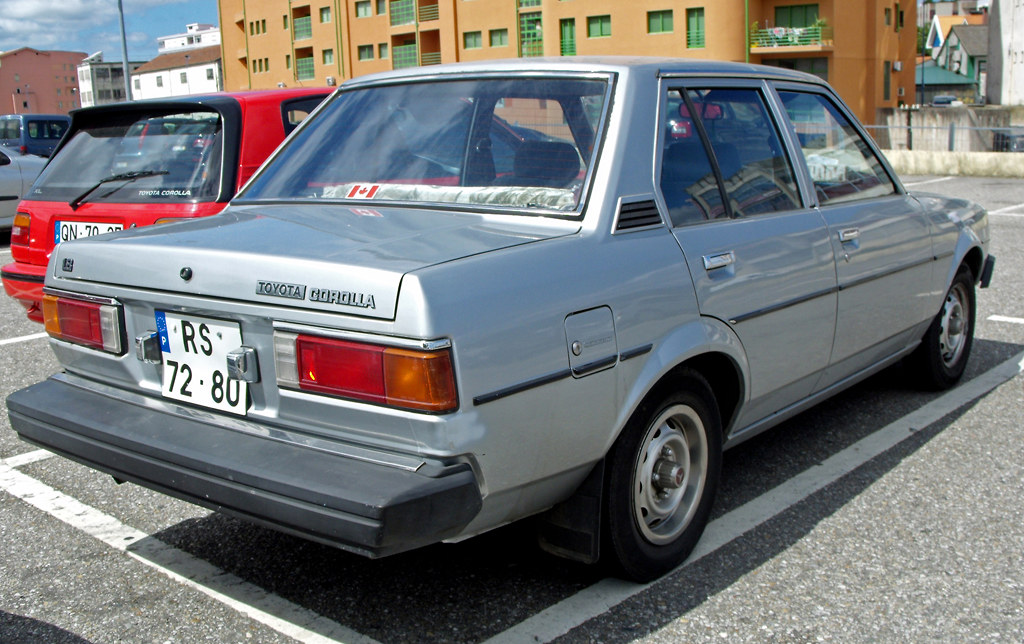 Sedan Corolla Early. These are very common taillights, but still pretty with the chrome trim![/caption]
[caption id="" align="aligncenter" width="1024"]
Sedan Corolla Early. These are very common taillights, but still pretty with the chrome trim![/caption]
[caption id="" align="aligncenter" width="1024"] Sedan Corolla Early. Same as the ones pictured above, but without chrome.[/caption]
[caption id="" align="aligncenter" width="1024"]
Sedan Corolla Early. Same as the ones pictured above, but without chrome.[/caption]
[caption id="" align="aligncenter" width="1024"]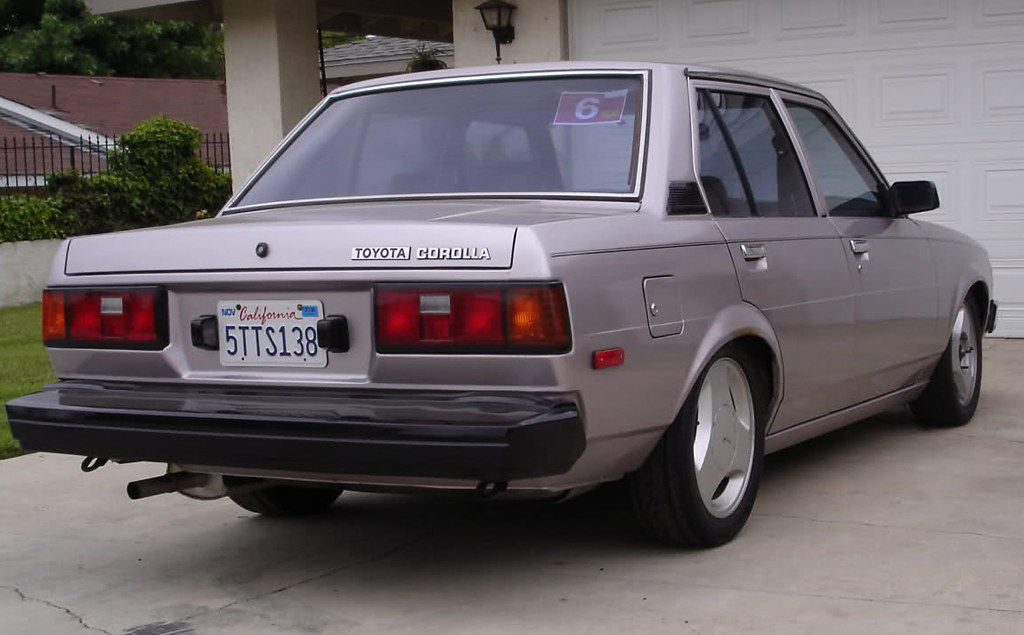 Sedan Corolla Late. Cleaned up and smoothed out was a common theme on late model taillights. I quite enjoy these as long as I ignore the weird Saab wheel swap trend from the 90's.[/caption]
[caption id="" align="aligncenter" width="1024"]
Sedan Corolla Late. Cleaned up and smoothed out was a common theme on late model taillights. I quite enjoy these as long as I ignore the weird Saab wheel swap trend from the 90's.[/caption]
[caption id="" align="aligncenter" width="1024"]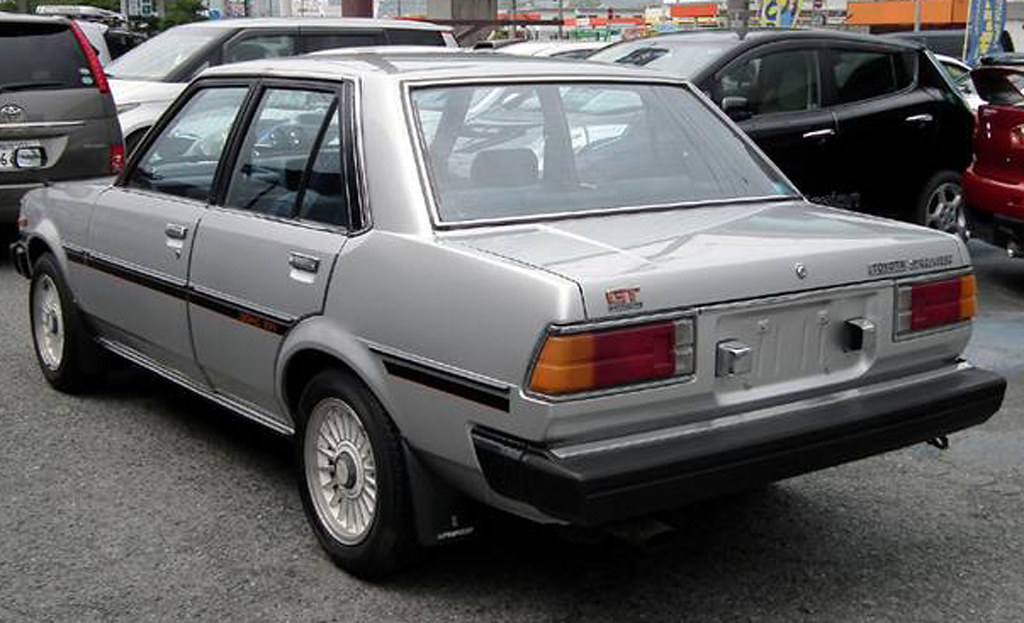 Sedan Sprinter Early. Note that the taillight and quarter panel are unique to the Sprinter and are not compatible with the corolla models.[/caption]
[caption id="" align="aligncenter" width="1024"]
Sedan Sprinter Early. Note that the taillight and quarter panel are unique to the Sprinter and are not compatible with the corolla models.[/caption]
[caption id="" align="aligncenter" width="1024"]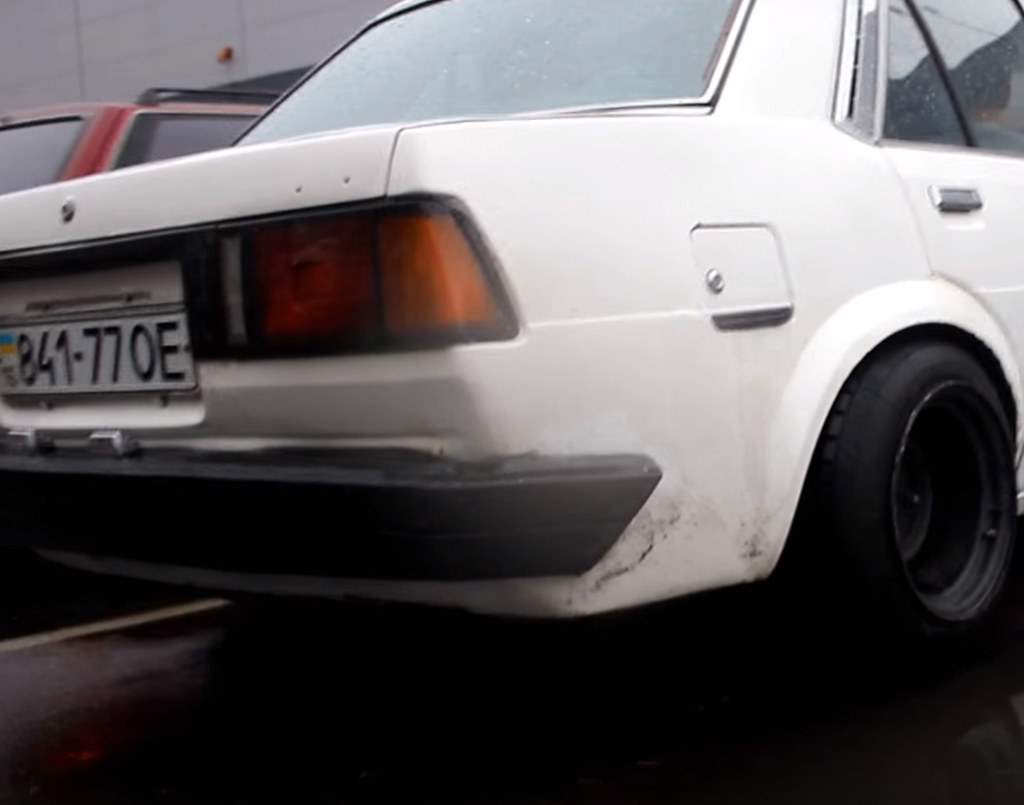 Sedan Sprinter Late. It was so hard to find this photo that I had to grab a still from a video.[/caption]
[caption id="" align="aligncenter" width="1024"]
Sedan Sprinter Late. It was so hard to find this photo that I had to grab a still from a video.[/caption]
[caption id="" align="aligncenter" width="1024"]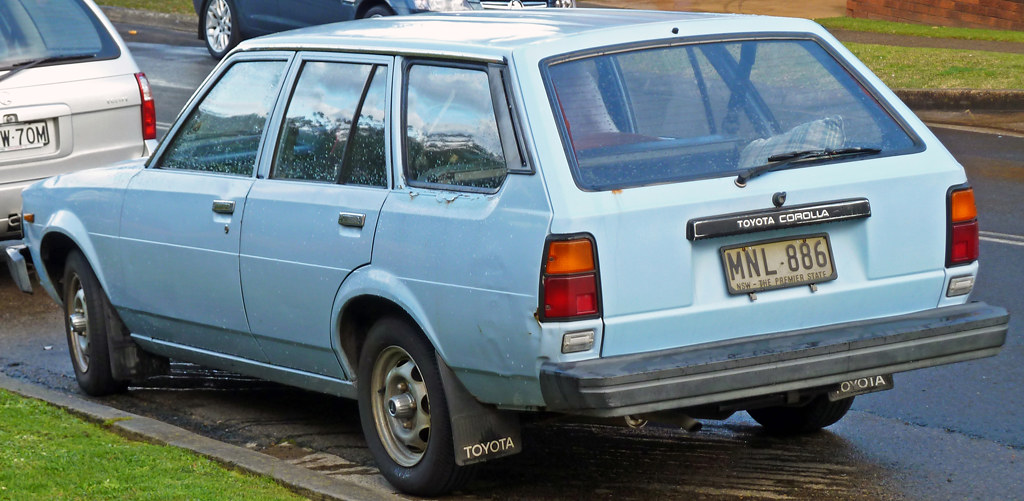 Wagon Early Black. [/caption]
[caption id="" align="aligncenter" width="1024"]
Wagon Early Black. [/caption]
[caption id="" align="aligncenter" width="1024"]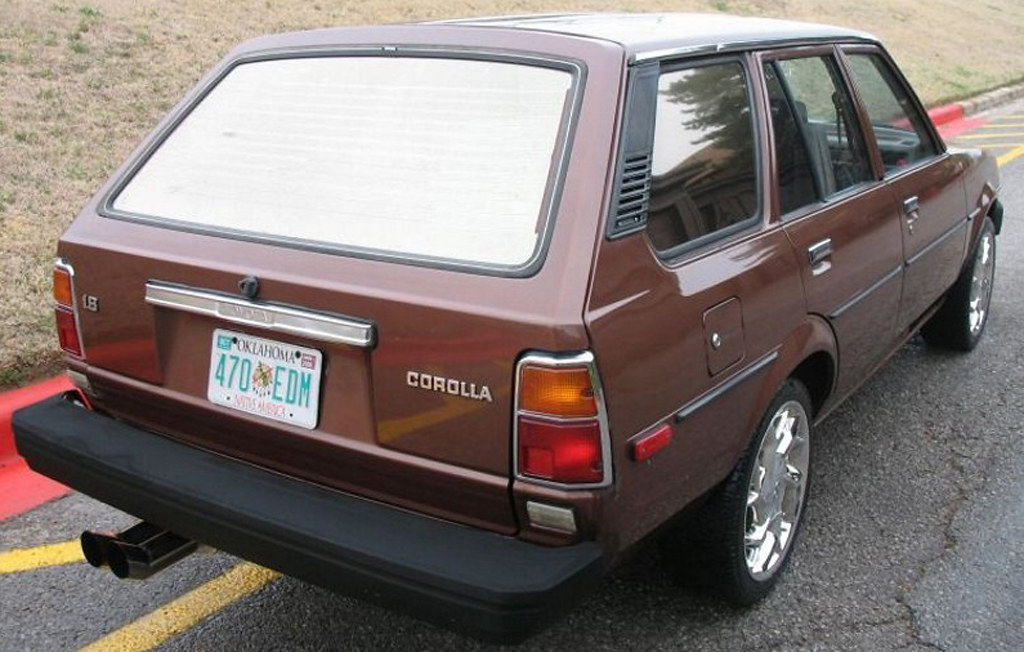 Wagon Early Chrome.[/caption]
[caption id="" align="aligncenter" width="1024"]
Wagon Early Chrome.[/caption]
[caption id="" align="aligncenter" width="1024"]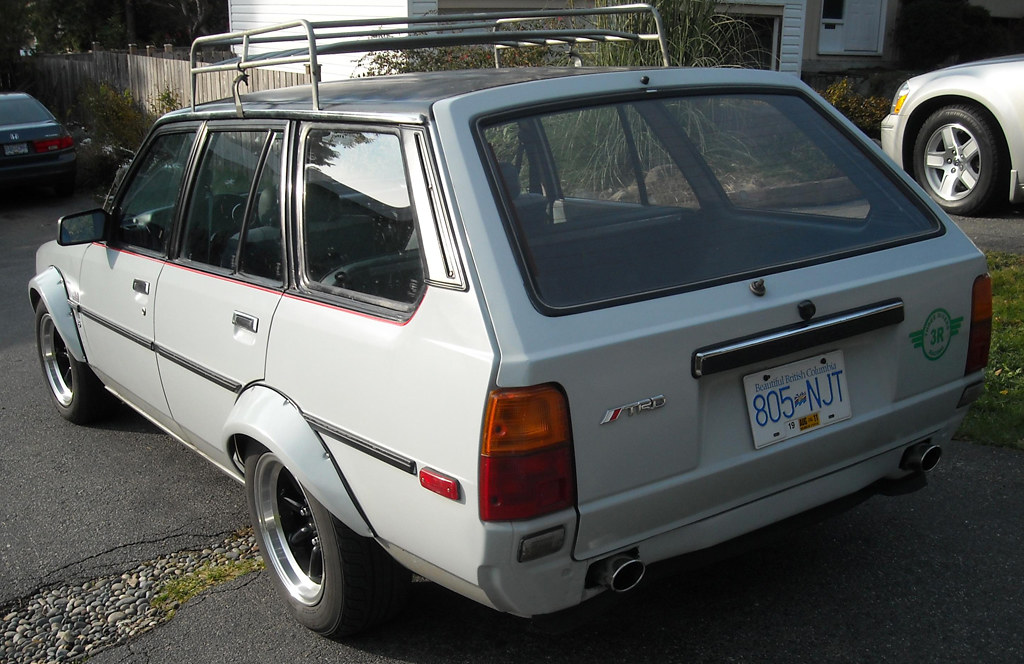 Wagon Late. These were also brought closer to a monochromatic feel like the late model sports and sedan tails.[/caption]
Engines.
Internationally there were 9 different engines available for the E7 Chassis. However, I'm just going to focus on the most common ones. To understand chassis codes a "KE70" would have a "K" series engines.
[caption id="" align="aligncenter" width="1024"]
Wagon Late. These were also brought closer to a monochromatic feel like the late model sports and sedan tails.[/caption]
Engines.
Internationally there were 9 different engines available for the E7 Chassis. However, I'm just going to focus on the most common ones. To understand chassis codes a "KE70" would have a "K" series engines.
[caption id="" align="aligncenter" width="1024"]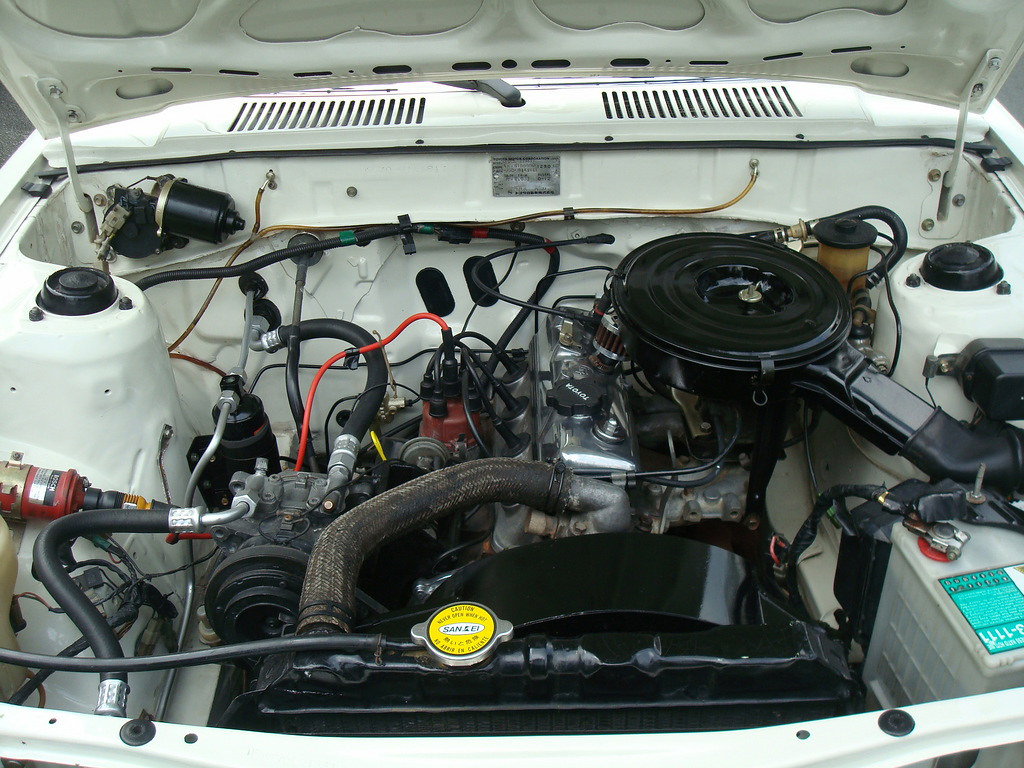 4K 1.3L OHV. This is where the "K" in KE70 comes from. 4K is common to Australia and many other countries. 7K swaps are common in these chassis. KE70's had steering racks.[/caption]
[caption id="" align="aligncenter" width="1024"]
4K 1.3L OHV. This is where the "K" in KE70 comes from. 4K is common to Australia and many other countries. 7K swaps are common in these chassis. KE70's had steering racks.[/caption]
[caption id="" align="aligncenter" width="1024"]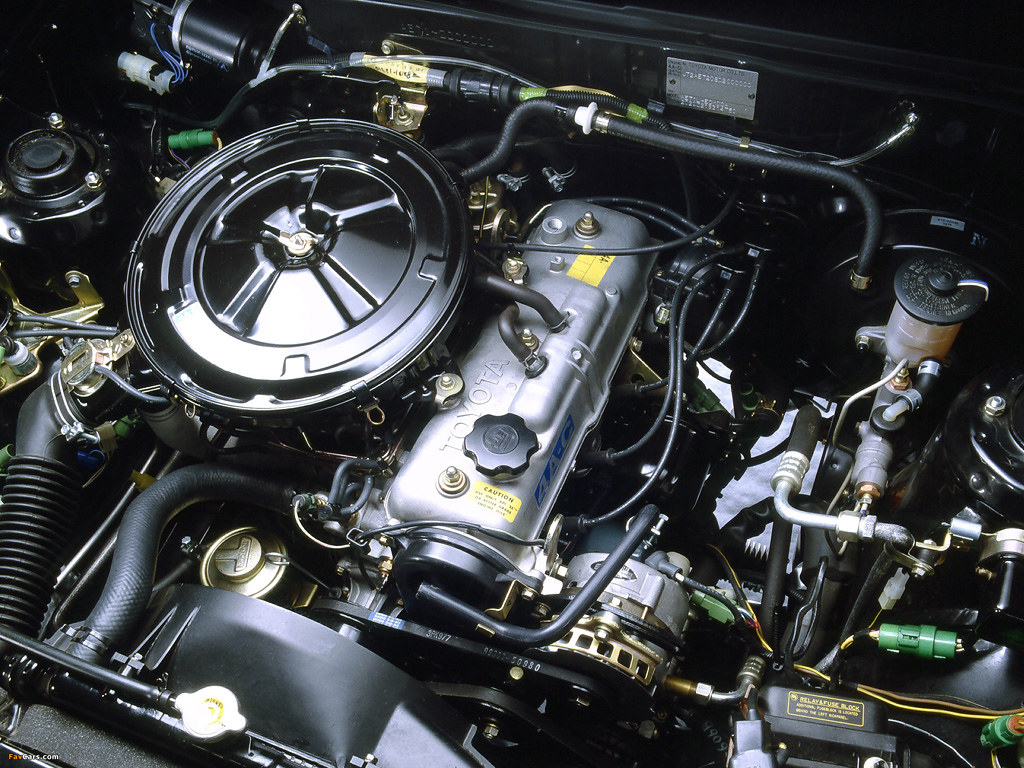 4AC 1.6L SOHC. This is the "A" in AE70. In North America these were one year only 1983. Japan had 3AC equipped models as well. 4/3AC cars had steering racks.[/caption]
[caption id="" align="aligncenter" width="1024"]
4AC 1.6L SOHC. This is the "A" in AE70. In North America these were one year only 1983. Japan had 3AC equipped models as well. 4/3AC cars had steering racks.[/caption]
[caption id="" align="aligncenter" width="1024"]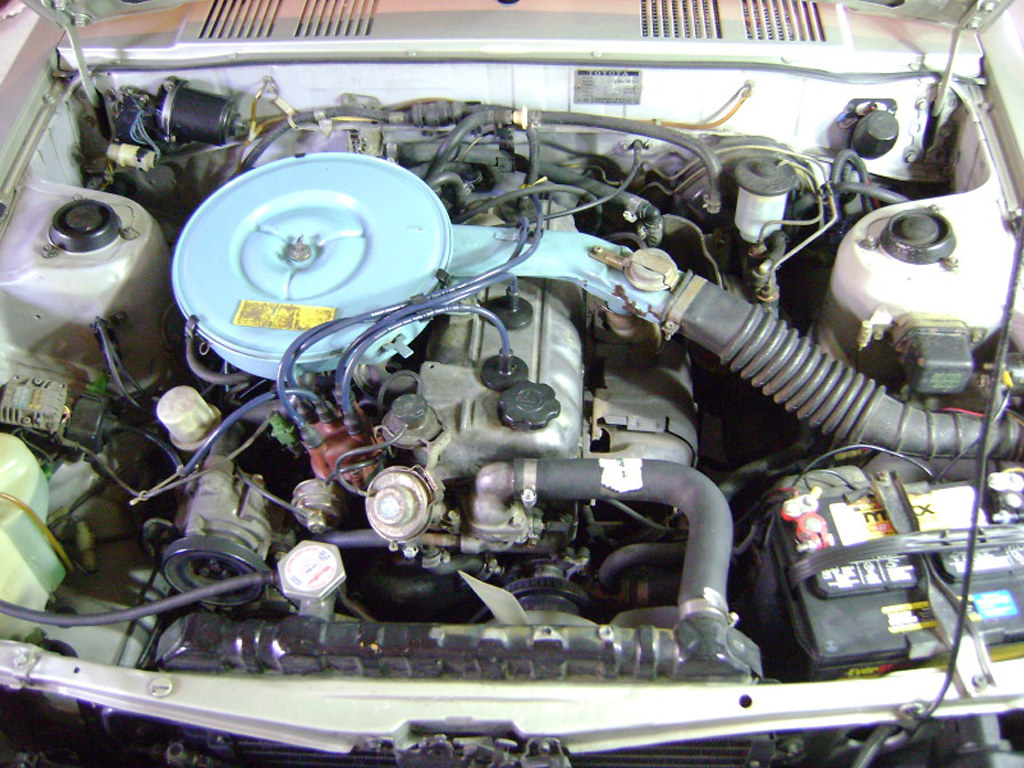 3TC 1.8L OHV. 1.8L often referred to as a ".8" car by those who enjoy Corollas in the Central American communities. 3TC cars had a steering box setup similar to the previous E3/E5 chassis 3rd gen corollas. Least desirable chassis for handling, but a great motor.[/caption]
[caption id="" align="aligncenter" width="1024"]
3TC 1.8L OHV. 1.8L often referred to as a ".8" car by those who enjoy Corollas in the Central American communities. 3TC cars had a steering box setup similar to the previous E3/E5 chassis 3rd gen corollas. Least desirable chassis for handling, but a great motor.[/caption]
[caption id="" align="aligncenter" width="1024"] 2TG 1.6L DOHC. Both the 3TC and 2TG would be considered "TE70" chassis. The 2TG was a 1.6L DOHC performance version found in Japan and I think Europe as well. I'm unsure if the 2TG equipped cars came with a steering box or rack.[/caption]
[caption id="" align="aligncenter" width="1024"]
2TG 1.6L DOHC. Both the 3TC and 2TG would be considered "TE70" chassis. The 2TG was a 1.6L DOHC performance version found in Japan and I think Europe as well. I'm unsure if the 2TG equipped cars came with a steering box or rack.[/caption]
[caption id="" align="aligncenter" width="1024"]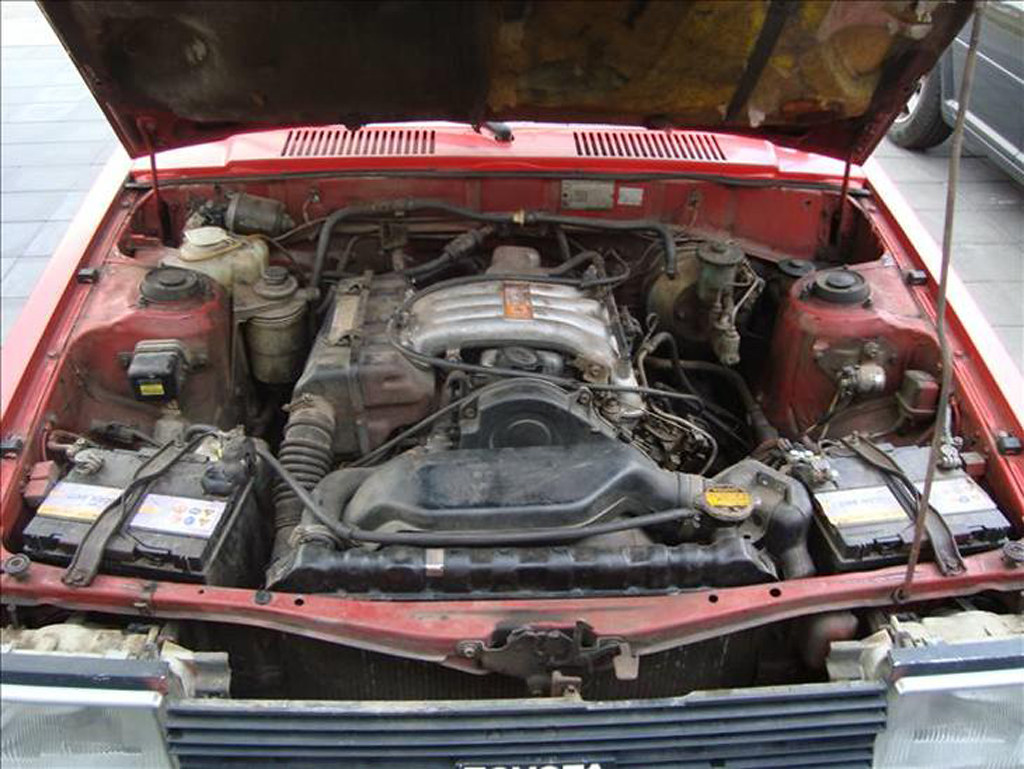 1C 1.8L Diesel. A Japan and European option, may have even made it to South America and Africa. 2C swaps are extremely common especially in developing countries.[/caption]
Well, that sums up the extent of my focus. There is far more information about these cars floating around, here's a good jump off point for you!
1C 1.8L Diesel. A Japan and European option, may have even made it to South America and Africa. 2C swaps are extremely common especially in developing countries.[/caption]
Well, that sums up the extent of my focus. There is far more information about these cars floating around, here's a good jump off point for you!
Share this post
Back to SPEED HERO Blog
 On a whim while building my scooter I asked Joel; "How many body styles of the E7 are there actually?" "I unno," he muttered back. Having reviewed my original E7 article long ago, I realized it was crappy, like all the other things I post. I spent a few hours collecting photos, to help build a better article than before.
For those of you in the know, the "E" in the chassis code is often associated with the Corolla name. What people often forget is that the Sprinter line of cars are also E Chassis codes. Corolla and Sprinter are both equally E chassis lines, the model of each follows after. For example; Toyota Corolla Levin, and Toyota Sprinter Trueno. Toyota is the manufacturer, Corolla is the line, and Levin is the model. This article includes both Corollas and Sprinters which have E7 Chassis codes.
What's special about the E7? It's a world car, meaning it was sold on every continent! I can go anywhere in the world and if I look hard enough I'll be able to find an E7 somewhere! I love world cars.
Body Styles:
Let's just jump to the meat of this article. How many are there? By my unofficial count there are approximately 20. You can call me out if you want, or send me some new information.
Within these body styles are 2 basic groups: Sedan and Sports. All E7's share a similar floor pans, for the most part. Wagons were leaf sprung, their rear half is a different section of floor pan than all other body styles. Note: that Left Hand drive cars with "T" series engines had a completely different firewall than all other E7 chassis!!! This affected the dash bar and pedal assemblies on these cars as well.
The noses between sedan models can be swapped between sedans, the same with the sports models as well, however, a sports nose and sedan nose cannot be swapped.
Sedans:
[caption id="" align="aligncenter" width="1024"]
On a whim while building my scooter I asked Joel; "How many body styles of the E7 are there actually?" "I unno," he muttered back. Having reviewed my original E7 article long ago, I realized it was crappy, like all the other things I post. I spent a few hours collecting photos, to help build a better article than before.
For those of you in the know, the "E" in the chassis code is often associated with the Corolla name. What people often forget is that the Sprinter line of cars are also E Chassis codes. Corolla and Sprinter are both equally E chassis lines, the model of each follows after. For example; Toyota Corolla Levin, and Toyota Sprinter Trueno. Toyota is the manufacturer, Corolla is the line, and Levin is the model. This article includes both Corollas and Sprinters which have E7 Chassis codes.
What's special about the E7? It's a world car, meaning it was sold on every continent! I can go anywhere in the world and if I look hard enough I'll be able to find an E7 somewhere! I love world cars.
Body Styles:
Let's just jump to the meat of this article. How many are there? By my unofficial count there are approximately 20. You can call me out if you want, or send me some new information.
Within these body styles are 2 basic groups: Sedan and Sports. All E7's share a similar floor pans, for the most part. Wagons were leaf sprung, their rear half is a different section of floor pan than all other body styles. Note: that Left Hand drive cars with "T" series engines had a completely different firewall than all other E7 chassis!!! This affected the dash bar and pedal assemblies on these cars as well.
The noses between sedan models can be swapped between sedans, the same with the sports models as well, however, a sports nose and sedan nose cannot be swapped.
Sedans:
[caption id="" align="aligncenter" width="1024"] 4 Door Corolla Sedan. Note the rear door shape and C-pillar shape, This differs between the Sprinter 4 door sedan pictured below. These Corolla rear sedan doors differ from the rear wagon doors. Pictured is the tried and true classic, and what model people know as an "E7" or often referred to as a complete chassis code of "KE70". This is the most common bodystyle found internationally. The nose and taillights may differ depending on year and continent. There were 3 basic versions, and Early, Mid, and Late version of the Corolla sedan. The Early version is pictured above with the "Quads" nose. We'll cover all in this article.[/caption]
[caption id="" align="aligncenter" width="1024"]
4 Door Corolla Sedan. Note the rear door shape and C-pillar shape, This differs between the Sprinter 4 door sedan pictured below. These Corolla rear sedan doors differ from the rear wagon doors. Pictured is the tried and true classic, and what model people know as an "E7" or often referred to as a complete chassis code of "KE70". This is the most common bodystyle found internationally. The nose and taillights may differ depending on year and continent. There were 3 basic versions, and Early, Mid, and Late version of the Corolla sedan. The Early version is pictured above with the "Quads" nose. We'll cover all in this article.[/caption]
[caption id="" align="aligncenter" width="1024"] 4 Door Sedan Sprinter. These doors are compatible with the wagon 4 door rear doors, as far as I know. These are extremely rare. Pictured is an early version of the Sprinter, most likely a 1979.[/caption]
[caption id="" align="aligncenter" width="1024"]
4 Door Sedan Sprinter. These doors are compatible with the wagon 4 door rear doors, as far as I know. These are extremely rare. Pictured is an early version of the Sprinter, most likely a 1979.[/caption]
[caption id="" align="aligncenter" width="1024"] 2 Door Sedan. This is NOT the coupe. It's easy to call it a coupe, due to only having 2 doors, but there is a Sports model by that name already. This is the 2 door sedan. Pictured above is a late model European nose and taillights.[/caption]
Sedans subcatagory: Wagons/Vans
This is where things get really tricky. There is TONS of versions of the wagon/van. I tried my absolute best to get every version of the wagon/van. Please ignore the noses, as they are interchangeable. The doors, roof height and the windows equipped are the variations that are important. Some of these were called "Vans" because in Japan a 'Van' denotes purpose for work, and 'Wagon' denotes purpose for home/pleasure.
--Low Roof
[caption id="" align="aligncenter" width="1024"]
2 Door Sedan. This is NOT the coupe. It's easy to call it a coupe, due to only having 2 doors, but there is a Sports model by that name already. This is the 2 door sedan. Pictured above is a late model European nose and taillights.[/caption]
Sedans subcatagory: Wagons/Vans
This is where things get really tricky. There is TONS of versions of the wagon/van. I tried my absolute best to get every version of the wagon/van. Please ignore the noses, as they are interchangeable. The doors, roof height and the windows equipped are the variations that are important. Some of these were called "Vans" because in Japan a 'Van' denotes purpose for work, and 'Wagon' denotes purpose for home/pleasure.
--Low Roof
[caption id="" align="aligncenter" width="1024"] Low Roof 4 Door Wagon. This is the most common of the E7 chassis's. It is also the second most common of all E7's made, next two the Corolla 4 door sedan.[/caption]
[caption id="" align="aligncenter" width="1024"]
Low Roof 4 Door Wagon. This is the most common of the E7 chassis's. It is also the second most common of all E7's made, next two the Corolla 4 door sedan.[/caption]
[caption id="" align="aligncenter" width="1024"] Low Roof 2 Door Wagon, Factory Glass. The rear windows on this were not dealer installed, but factory installed. The front doors of this MAY (unconfirmed) swap between the 2 door sedan.[/caption]
[caption id="" align="aligncenter" width="1024"]
Low Roof 2 Door Wagon, Factory Glass. The rear windows on this were not dealer installed, but factory installed. The front doors of this MAY (unconfirmed) swap between the 2 door sedan.[/caption]
[caption id="" align="aligncenter" width="1024"] Low Roof 2 Door Wagon. This is the Panel van. It has stamped steel sheet where the factory windows could've been installed.[/caption]
[caption id="" align="aligncenter" width="1024"]
Low Roof 2 Door Wagon. This is the Panel van. It has stamped steel sheet where the factory windows could've been installed.[/caption]
[caption id="" align="aligncenter" width="1024"] Low Roof 2 Door Wagon, Dual Dealer Windows. The wagons are complex. Windows in the rear were optional for customers needs. Often these cars were used as work vans, and customers could decide which windows they wanted installed. You'll notice the glass is smaller on the panel windows than on the factory installed windows.[/caption]
[caption id="" align="aligncenter" width="1024"]
Low Roof 2 Door Wagon, Dual Dealer Windows. The wagons are complex. Windows in the rear were optional for customers needs. Often these cars were used as work vans, and customers could decide which windows they wanted installed. You'll notice the glass is smaller on the panel windows than on the factory installed windows.[/caption]
[caption id="" align="aligncenter" width="1024"] Low Roof 2 Door Wagon, Front Dealer Window. This customer opted for only the front of the dealer installed panel windows.[/caption]
[caption id="" align="aligncenter" width="1024"]
Low Roof 2 Door Wagon, Front Dealer Window. This customer opted for only the front of the dealer installed panel windows.[/caption]
[caption id="" align="aligncenter" width="1024"] Low Roof 2 Door Wagon, Rear Window. This is a bit of a cheat as the rear are factory windows. There were many dealer installed styles like this.[/caption]
--High Roof
These featured a higher roof than standard models for more head and cargo space.
[caption id="" align="aligncenter" width="1024"]
Low Roof 2 Door Wagon, Rear Window. This is a bit of a cheat as the rear are factory windows. There were many dealer installed styles like this.[/caption]
--High Roof
These featured a higher roof than standard models for more head and cargo space.
[caption id="" align="aligncenter" width="1024"] High Roof 4 Door Wagon. This also features a rare, Japan only "Van" nose, which looks similar to the Carina van's of the time.[/caption]
[caption id="" align="aligncenter" width="1024"]
High Roof 4 Door Wagon. This also features a rare, Japan only "Van" nose, which looks similar to the Carina van's of the time.[/caption]
[caption id="" align="aligncenter" width="1024"] High Roof 2 Door Wagon, Factory Windows. This is a famous drift car owned by Katsuhiro Ueo. It too has the Japanese only "Van" nose.[/caption]
[caption id="" align="aligncenter" width="1024"]
High Roof 2 Door Wagon, Factory Windows. This is a famous drift car owned by Katsuhiro Ueo. It too has the Japanese only "Van" nose.[/caption]
[caption id="" align="aligncenter" width="1024"] High Roof 2 Door Wagon. This is the Panel van version. This is my favorite of all the E7 chassis types. Most commonly found in Australia, but were also sold in Europe.[/caption]
[caption id="" align="aligncenter" width="1024"]
High Roof 2 Door Wagon. This is the Panel van version. This is my favorite of all the E7 chassis types. Most commonly found in Australia, but were also sold in Europe.[/caption]
[caption id="" align="aligncenter" width="1024"] High Roof 2 Door Wagon, Dual Dealer Windows.[/caption]
[caption id="" align="aligncenter" width="1024"]
High Roof 2 Door Wagon, Dual Dealer Windows.[/caption]
[caption id="" align="aligncenter" width="1024"] High Roof 2 Door Wagon, Front Dealer Window. This is a late model Australian, which was sold as a Corolla, even though they used the late Japanese Sprinter nose. It is common for the Australian models to mix and match Sprinter and Corolla parts from the Factory.[/caption]
[caption id="" align="aligncenter" width="1024"]
High Roof 2 Door Wagon, Front Dealer Window. This is a late model Australian, which was sold as a Corolla, even though they used the late Japanese Sprinter nose. It is common for the Australian models to mix and match Sprinter and Corolla parts from the Factory.[/caption]
[caption id="" align="aligncenter" width="1024"] High Roof 2 Door Wagon, Rear Dealer Window.[/caption]
Sports
These body styles, although the same underpan and engine bay as the sedans, have a completely different body line than the Sedan style cars above. Only Noses and taillights can be swapped between sport body styles. The sedan exterior parts are not compatible.
[caption id="" align="aligncenter" width="1024"]
High Roof 2 Door Wagon, Rear Dealer Window.[/caption]
Sports
These body styles, although the same underpan and engine bay as the sedans, have a completely different body line than the Sedan style cars above. Only Noses and taillights can be swapped between sport body styles. The sedan exterior parts are not compatible.
[caption id="" align="aligncenter" width="1024"] Coupe. This car is not called a hatchback, or fast back, it is the coupe. Which is often what people mistakenly call the 2 door sedan.[/caption]
[caption id="" align="aligncenter" width="1024"]
Coupe. This car is not called a hatchback, or fast back, it is the coupe. Which is often what people mistakenly call the 2 door sedan.[/caption]
[caption id="" align="aligncenter" width="1024"] Hardtop. It's a strange name, but it's a throw back name to cars of the 1960's. "Hardtop" meant a car with a hard roof, but no "B" pillars. This was an American term that the Japanese continued to use until "Hardtop" designs were banned for better roll over protection. Both this car pictured above, and the one below have the same missing B-pillar. The door windows roll down, but also the small triangular windows behind the front door also roll down for rear passengers.[/caption]
[caption id="" align="aligncenter" width="1024"]
Hardtop. It's a strange name, but it's a throw back name to cars of the 1960's. "Hardtop" meant a car with a hard roof, but no "B" pillars. This was an American term that the Japanese continued to use until "Hardtop" designs were banned for better roll over protection. Both this car pictured above, and the one below have the same missing B-pillar. The door windows roll down, but also the small triangular windows behind the front door also roll down for rear passengers.[/caption]
[caption id="" align="aligncenter" width="1024"] Liftback. This shares the missing B-pillar with the hardtop. It functions like owning a 2-door Wagon, but is called a Liftback and has Sport type body panels. Weirdly enough this was sold as a completely separate model in Australia labeled "T18". This was to denote it's 3TC engine, where all other E7 corollas in Australia had 4KC or 4AC engines with steering racks, the T18 was the only model with the 3TC and steering box.[/caption]
[caption id="" align="aligncenter" width="1024"]
Liftback. This shares the missing B-pillar with the hardtop. It functions like owning a 2-door Wagon, but is called a Liftback and has Sport type body panels. Weirdly enough this was sold as a completely separate model in Australia labeled "T18". This was to denote it's 3TC engine, where all other E7 corollas in Australia had 4KC or 4AC engines with steering racks, the T18 was the only model with the 3TC and steering box.[/caption]
[caption id="" align="aligncenter" width="1024"] Convertible. A rare, American only model. This was converted by coach builder Griffith on Toyotas behalf and sold through the Toyota dealership.[/caption]
Bonus Car!!!
[caption id="" align="aligncenter" width="1024"]
Convertible. A rare, American only model. This was converted by coach builder Griffith on Toyotas behalf and sold through the Toyota dealership.[/caption]
Bonus Car!!!
[caption id="" align="aligncenter" width="1024"] Daihatsu Charmant. Yes, this is an E7! Toyota owns Daihatsu and the two are often sharing models. This is a completely rebodied E7 but shares the entire floor pan with the regular Sedan based models.[/caption]
Noses:
Here we cover the basic versions of front ends available on the differing E7 models. Use this as a rough guide for identification of year and continent of origin.
Sedans:
[caption id="" align="aligncenter" width="1024"]
Daihatsu Charmant. Yes, this is an E7! Toyota owns Daihatsu and the two are often sharing models. This is a completely rebodied E7 but shares the entire floor pan with the regular Sedan based models.[/caption]
Noses:
Here we cover the basic versions of front ends available on the differing E7 models. Use this as a rough guide for identification of year and continent of origin.
Sedans:
[caption id="" align="aligncenter" width="1024"] Sedan Corolla Early. This is the famous and most loved "Quads" nose. It only fits on sedan based models. Quads were a 1979-1980 only option found in Japan and North America. Pictured above is a 1980, as 79's had silver, not black, headlight buckets.[/caption]
[caption id="" align="aligncenter" width="1024"]
Sedan Corolla Early. This is the famous and most loved "Quads" nose. It only fits on sedan based models. Quads were a 1979-1980 only option found in Japan and North America. Pictured above is a 1980, as 79's had silver, not black, headlight buckets.[/caption]
[caption id="" align="aligncenter" width="1024"] Sedan Corolla Mid. This was a 1980-81 Nose depending on your market. This is the most commonly found nose internationally. Often referred to as "flat" front. The fenders and thin corner marker lights are the same between the Flat and Quad nose, but change on the later models.[/caption]
[caption id="" align="aligncenter" width="1024"]
Sedan Corolla Mid. This was a 1980-81 Nose depending on your market. This is the most commonly found nose internationally. Often referred to as "flat" front. The fenders and thin corner marker lights are the same between the Flat and Quad nose, but change on the later models.[/caption]
[caption id="" align="aligncenter" width="1024"] Sedan Corolla Mid. This is a rare, European only version with integrated fog lights.[/caption]
[caption id="" align="aligncenter" width="1024"]
Sedan Corolla Mid. This is a rare, European only version with integrated fog lights.[/caption]
[caption id="" align="aligncenter" width="1024"] Sedan Corolla Late. The "cheese wedge" nose has unique fenders to that of the early and mid noses. Easily spotted by the large triangular corner lights. These are sometimes clear rather than amber on other markets and models. 1982-83[/caption]
[caption id="" align="aligncenter" width="1024"]
Sedan Corolla Late. The "cheese wedge" nose has unique fenders to that of the early and mid noses. Easily spotted by the large triangular corner lights. These are sometimes clear rather than amber on other markets and models. 1982-83[/caption]
[caption id="" align="aligncenter" width="1024"] Sedan Corolla Late. This is a Japanese and European only nose with flush molded headlights and clear cheese wedge corner light fender combo. I can only assume these use an H4 replaceable bulb rather than the sealed halogens of previous models. 1982-83[/caption]
[caption id="" align="aligncenter" width="1024"]
Sedan Corolla Late. This is a Japanese and European only nose with flush molded headlights and clear cheese wedge corner light fender combo. I can only assume these use an H4 replaceable bulb rather than the sealed halogens of previous models. 1982-83[/caption]
[caption id="" align="aligncenter" width="1024"] Sedan Sprinter Early. Often found on 79-80 model sprinters. Pretty rare nose as the number of Corollas sold far outweighed that of the unpopular sprinter line.[/caption]
[caption id="" align="aligncenter" width="1024"]
Sedan Sprinter Early. Often found on 79-80 model sprinters. Pretty rare nose as the number of Corollas sold far outweighed that of the unpopular sprinter line.[/caption]
[caption id="" align="aligncenter" width="1024"] Sedan Sprinter Late. This is a tricky nose. In Japan this was a Sprinter nose, and you can confirm by the license plate and the the rear doors in this picture. However, Australia received this as their late Corolla nose. It's common for other markets outside of Japan to have Corolla and Sprinter parts mixed. Often referred to as a "slant nose". 1983 and maybe 1984 in some markets.[/caption]
Sports:
These noses are not interchangeable with Sedan noses. You will see some grill and headlight swaps between the two, but requires custom fabrication and questionable taste.
[caption id="" align="aligncenter" width="1024"]
Sedan Sprinter Late. This is a tricky nose. In Japan this was a Sprinter nose, and you can confirm by the license plate and the the rear doors in this picture. However, Australia received this as their late Corolla nose. It's common for other markets outside of Japan to have Corolla and Sprinter parts mixed. Often referred to as a "slant nose". 1983 and maybe 1984 in some markets.[/caption]
Sports:
These noses are not interchangeable with Sedan noses. You will see some grill and headlight swaps between the two, but requires custom fabrication and questionable taste.
[caption id="" align="aligncenter" width="1024"] Sports Corolla Early. Pretty common nose, was used on Sports models internationally from 1979 through 1983.[/caption]
[caption id="" align="aligncenter" width="1024"]
Sports Corolla Early. Pretty common nose, was used on Sports models internationally from 1979 through 1983.[/caption]
[caption id="" align="aligncenter" width="1024"] Sports Corolla Early. Same as above, but the European version with clear corners and fender marker lights.[/caption]
[caption id="" align="aligncenter" width="1024"]
Sports Corolla Early. Same as above, but the European version with clear corners and fender marker lights.[/caption]
[caption id="" align="aligncenter" width="1024"] Sports Corolla Late. Flush mounted headlights. I'm pretty sure this nose was Japan only.[/caption]
[caption id="" align="aligncenter" width="1024"]
Sports Corolla Late. Flush mounted headlights. I'm pretty sure this nose was Japan only.[/caption]
[caption id="" align="aligncenter" width="1024"] Sports Sprinter Early. Rare nose, pretty sure this is a Japanese only nose. Though I've seen E7's from the Philippians with these noses.[/caption]
[caption id="" align="aligncenter" width="1024"]
Sports Sprinter Early. Rare nose, pretty sure this is a Japanese only nose. Though I've seen E7's from the Philippians with these noses.[/caption]
[caption id="" align="aligncenter" width="1024"] Sports Sprinter Late. Molded headlights, Japan Only.[/caption]
Tails
Mostly just variations in taillights. My information on these are a bit blurry as the back is the least common place people take photos.
Sedans
[caption id="" align="aligncenter" width="1024"]
Sports Sprinter Late. Molded headlights, Japan Only.[/caption]
Tails
Mostly just variations in taillights. My information on these are a bit blurry as the back is the least common place people take photos.
Sedans
[caption id="" align="aligncenter" width="1024"] Sedan Corolla Early. These are very common taillights, but still pretty with the chrome trim![/caption]
[caption id="" align="aligncenter" width="1024"]
Sedan Corolla Early. These are very common taillights, but still pretty with the chrome trim![/caption]
[caption id="" align="aligncenter" width="1024"] Sedan Corolla Early. Same as the ones pictured above, but without chrome.[/caption]
[caption id="" align="aligncenter" width="1024"]
Sedan Corolla Early. Same as the ones pictured above, but without chrome.[/caption]
[caption id="" align="aligncenter" width="1024"] Sedan Corolla Late. Cleaned up and smoothed out was a common theme on late model taillights. I quite enjoy these as long as I ignore the weird Saab wheel swap trend from the 90's.[/caption]
[caption id="" align="aligncenter" width="1024"]
Sedan Corolla Late. Cleaned up and smoothed out was a common theme on late model taillights. I quite enjoy these as long as I ignore the weird Saab wheel swap trend from the 90's.[/caption]
[caption id="" align="aligncenter" width="1024"] Sedan Sprinter Early. Note that the taillight and quarter panel are unique to the Sprinter and are not compatible with the corolla models.[/caption]
[caption id="" align="aligncenter" width="1024"]
Sedan Sprinter Early. Note that the taillight and quarter panel are unique to the Sprinter and are not compatible with the corolla models.[/caption]
[caption id="" align="aligncenter" width="1024"] Sedan Sprinter Late. It was so hard to find this photo that I had to grab a still from a video.[/caption]
[caption id="" align="aligncenter" width="1024"]
Sedan Sprinter Late. It was so hard to find this photo that I had to grab a still from a video.[/caption]
[caption id="" align="aligncenter" width="1024"] Wagon Early Black. [/caption]
[caption id="" align="aligncenter" width="1024"]
Wagon Early Black. [/caption]
[caption id="" align="aligncenter" width="1024"] Wagon Early Chrome.[/caption]
[caption id="" align="aligncenter" width="1024"]
Wagon Early Chrome.[/caption]
[caption id="" align="aligncenter" width="1024"] Wagon Late. These were also brought closer to a monochromatic feel like the late model sports and sedan tails.[/caption]
Engines.
Internationally there were 9 different engines available for the E7 Chassis. However, I'm just going to focus on the most common ones. To understand chassis codes a "KE70" would have a "K" series engines.
[caption id="" align="aligncenter" width="1024"]
Wagon Late. These were also brought closer to a monochromatic feel like the late model sports and sedan tails.[/caption]
Engines.
Internationally there were 9 different engines available for the E7 Chassis. However, I'm just going to focus on the most common ones. To understand chassis codes a "KE70" would have a "K" series engines.
[caption id="" align="aligncenter" width="1024"] 4K 1.3L OHV. This is where the "K" in KE70 comes from. 4K is common to Australia and many other countries. 7K swaps are common in these chassis. KE70's had steering racks.[/caption]
[caption id="" align="aligncenter" width="1024"]
4K 1.3L OHV. This is where the "K" in KE70 comes from. 4K is common to Australia and many other countries. 7K swaps are common in these chassis. KE70's had steering racks.[/caption]
[caption id="" align="aligncenter" width="1024"] 4AC 1.6L SOHC. This is the "A" in AE70. In North America these were one year only 1983. Japan had 3AC equipped models as well. 4/3AC cars had steering racks.[/caption]
[caption id="" align="aligncenter" width="1024"]
4AC 1.6L SOHC. This is the "A" in AE70. In North America these were one year only 1983. Japan had 3AC equipped models as well. 4/3AC cars had steering racks.[/caption]
[caption id="" align="aligncenter" width="1024"] 3TC 1.8L OHV. 1.8L often referred to as a ".8" car by those who enjoy Corollas in the Central American communities. 3TC cars had a steering box setup similar to the previous E3/E5 chassis 3rd gen corollas. Least desirable chassis for handling, but a great motor.[/caption]
[caption id="" align="aligncenter" width="1024"]
3TC 1.8L OHV. 1.8L often referred to as a ".8" car by those who enjoy Corollas in the Central American communities. 3TC cars had a steering box setup similar to the previous E3/E5 chassis 3rd gen corollas. Least desirable chassis for handling, but a great motor.[/caption]
[caption id="" align="aligncenter" width="1024"] 2TG 1.6L DOHC. Both the 3TC and 2TG would be considered "TE70" chassis. The 2TG was a 1.6L DOHC performance version found in Japan and I think Europe as well. I'm unsure if the 2TG equipped cars came with a steering box or rack.[/caption]
[caption id="" align="aligncenter" width="1024"]
2TG 1.6L DOHC. Both the 3TC and 2TG would be considered "TE70" chassis. The 2TG was a 1.6L DOHC performance version found in Japan and I think Europe as well. I'm unsure if the 2TG equipped cars came with a steering box or rack.[/caption]
[caption id="" align="aligncenter" width="1024"] 1C 1.8L Diesel. A Japan and European option, may have even made it to South America and Africa. 2C swaps are extremely common especially in developing countries.[/caption]
Well, that sums up the extent of my focus. There is far more information about these cars floating around, here's a good jump off point for you!
1C 1.8L Diesel. A Japan and European option, may have even made it to South America and Africa. 2C swaps are extremely common especially in developing countries.[/caption]
Well, that sums up the extent of my focus. There is far more information about these cars floating around, here's a good jump off point for you!
So much info in here this dope!
excellent article, very well detailed!
Well done… needed this info for my own sites!